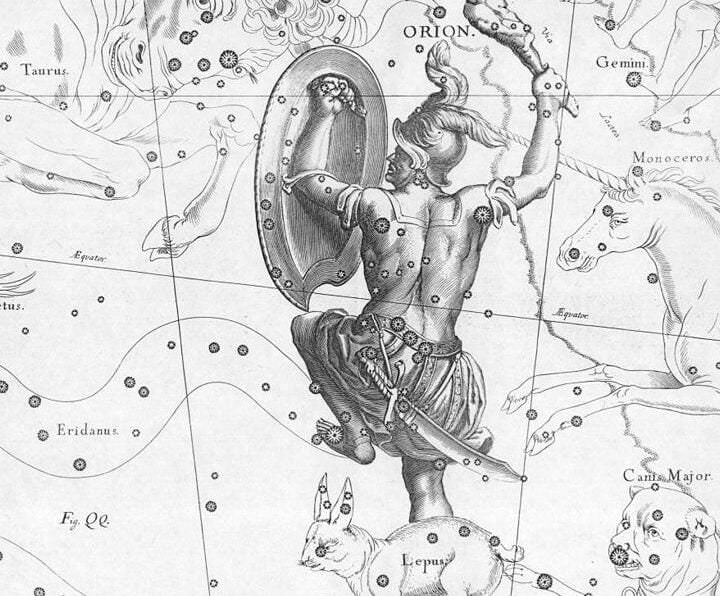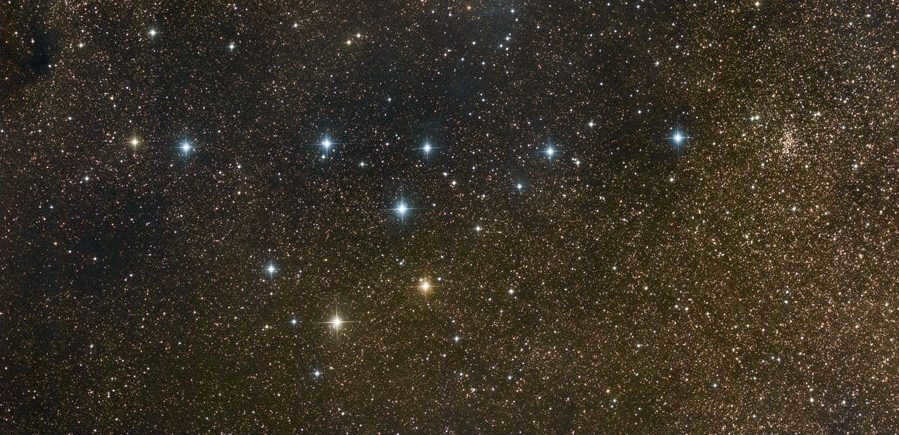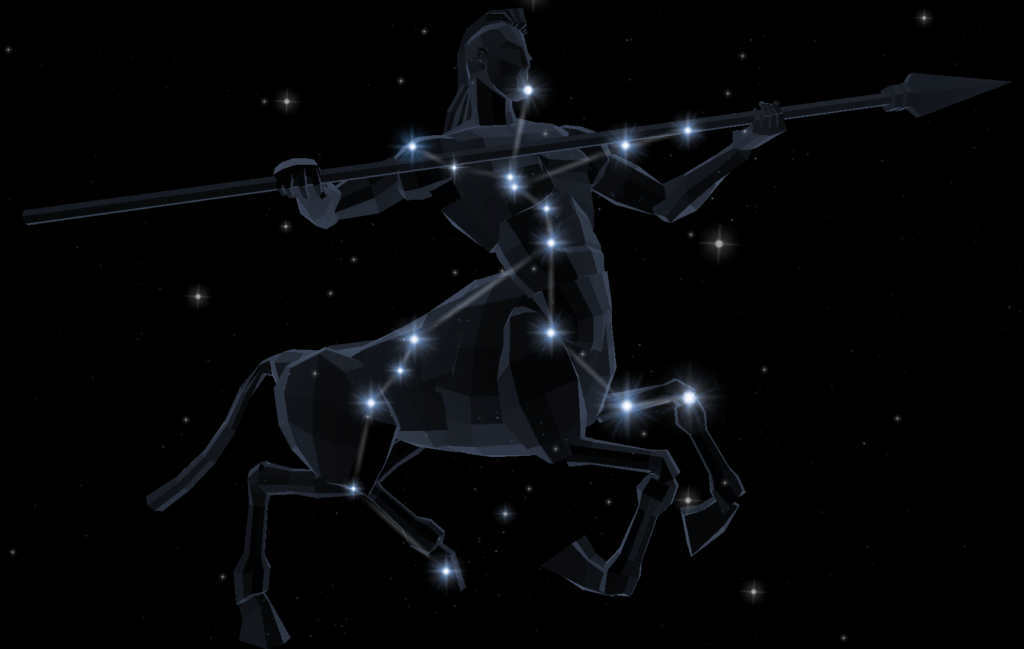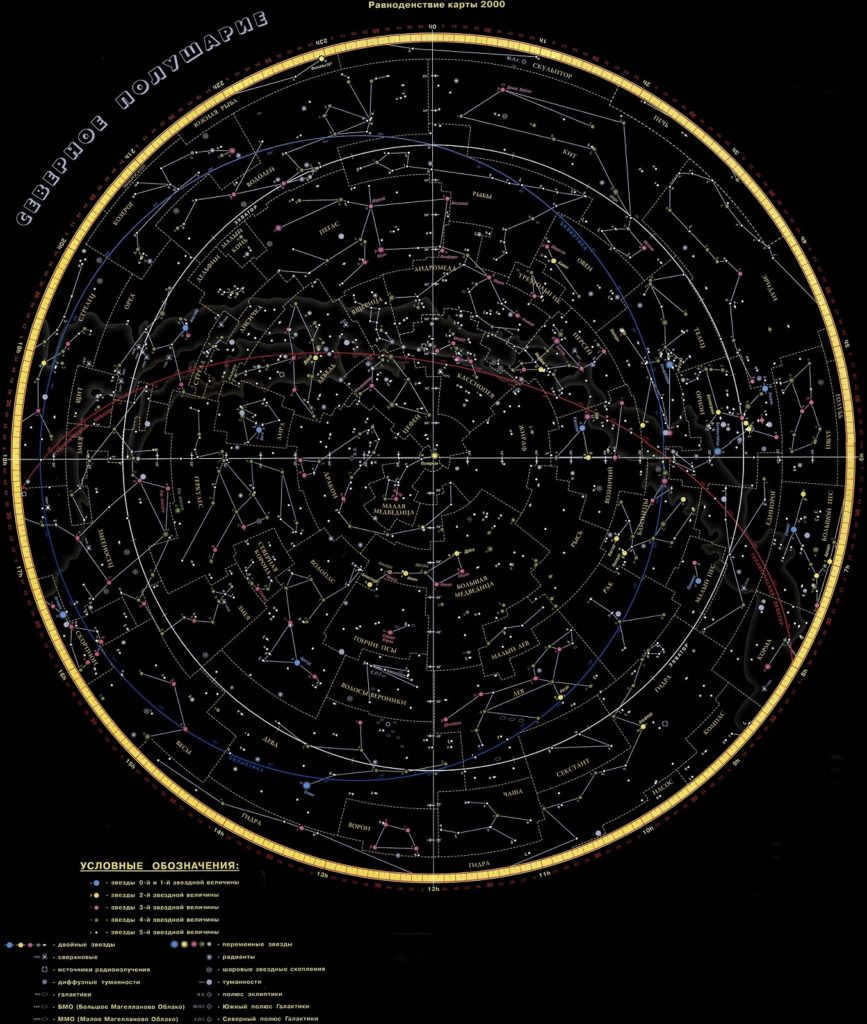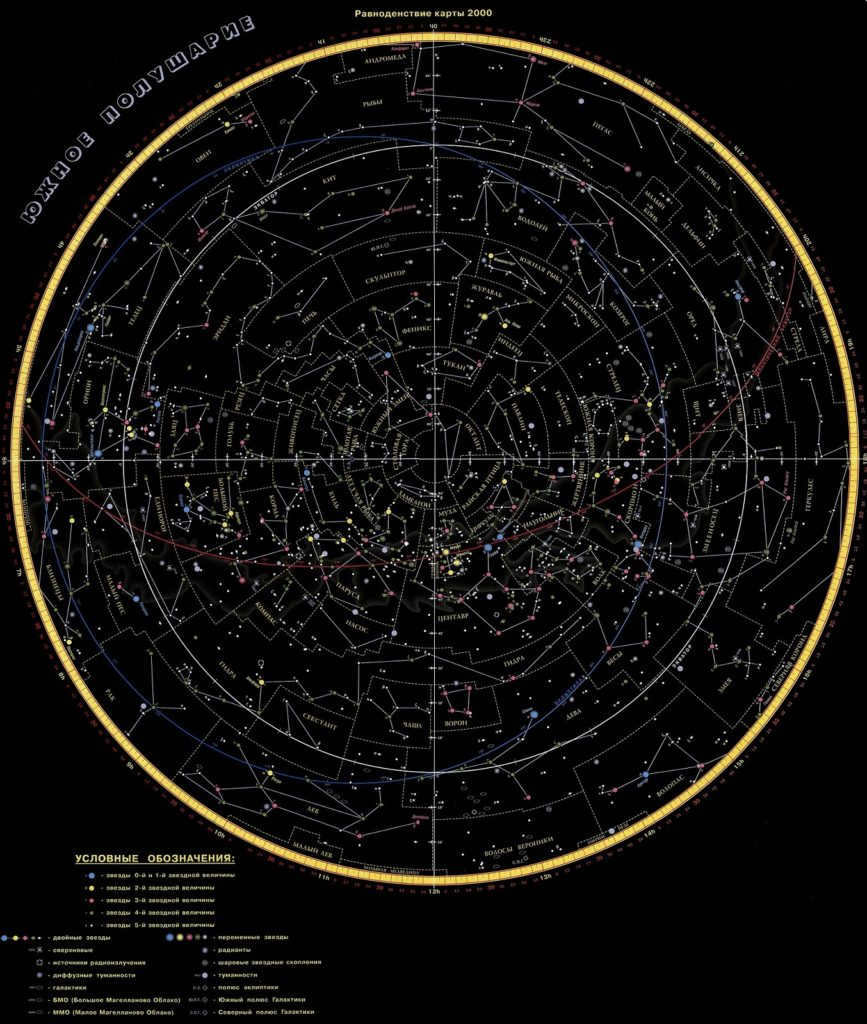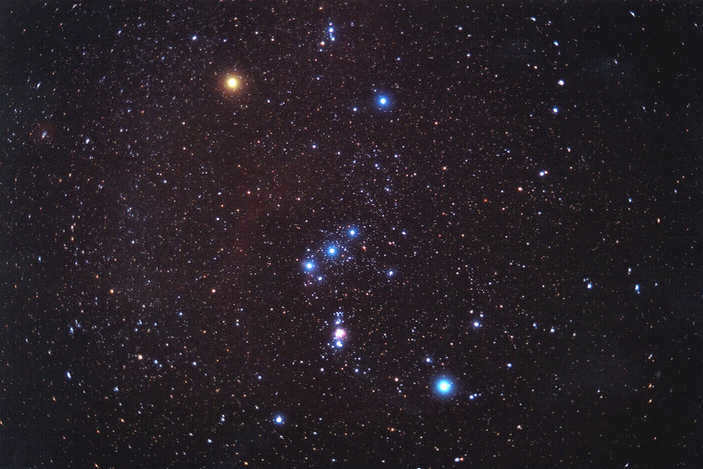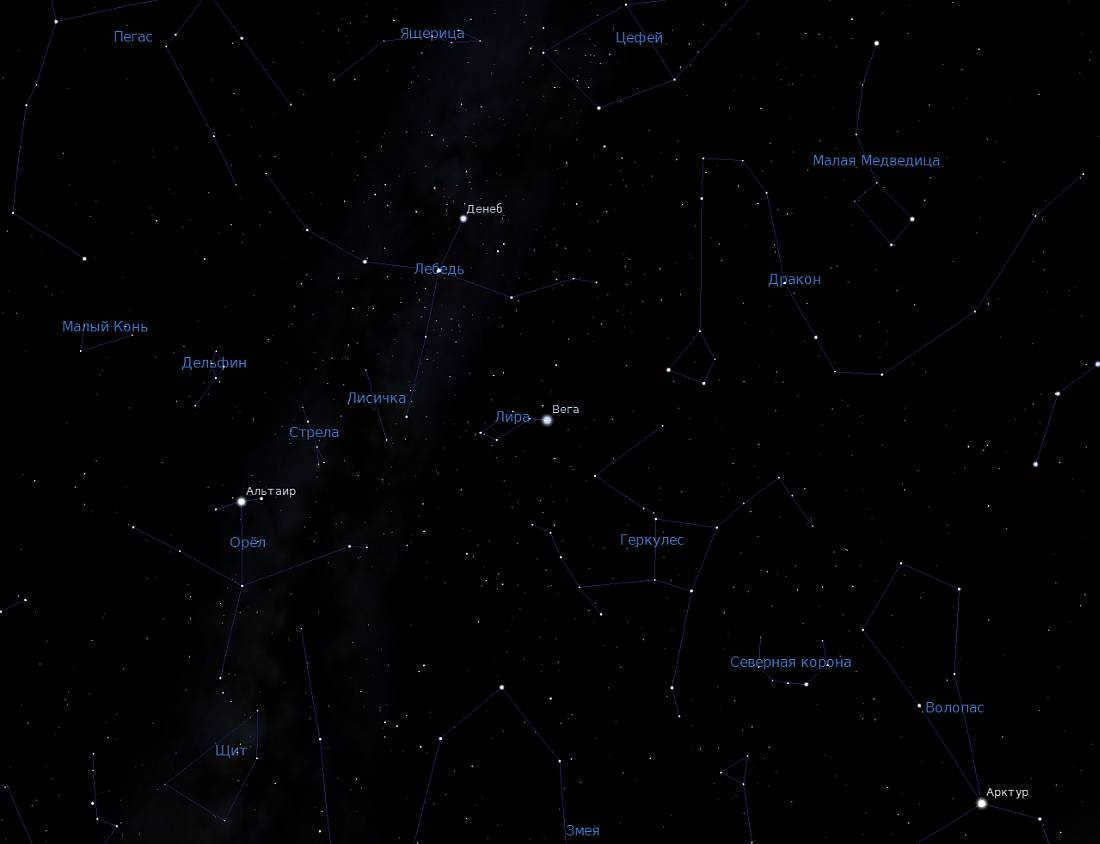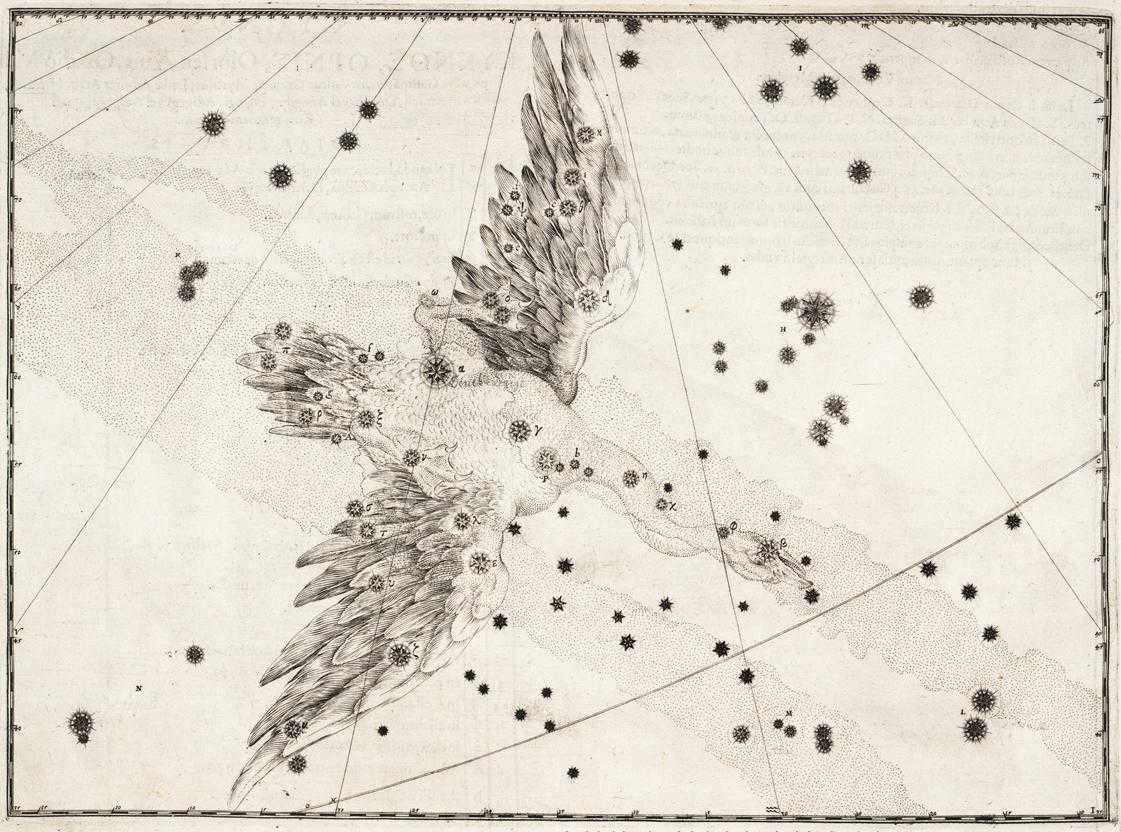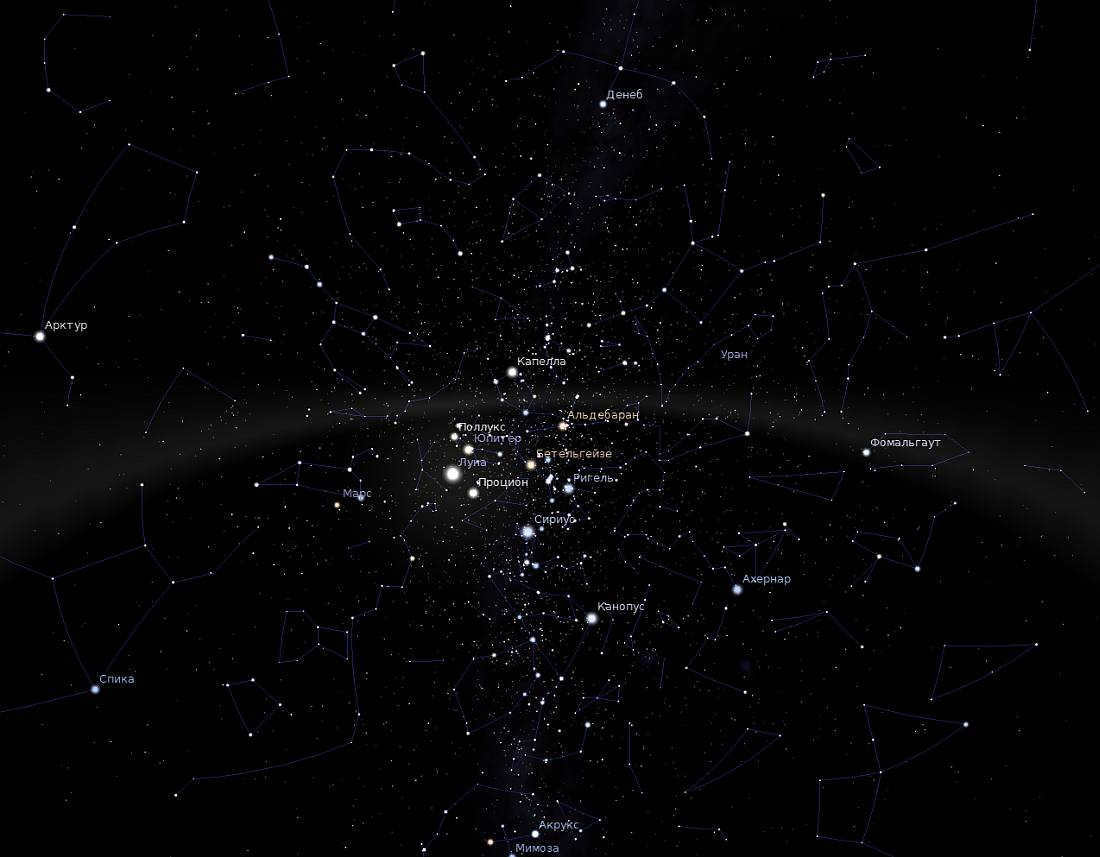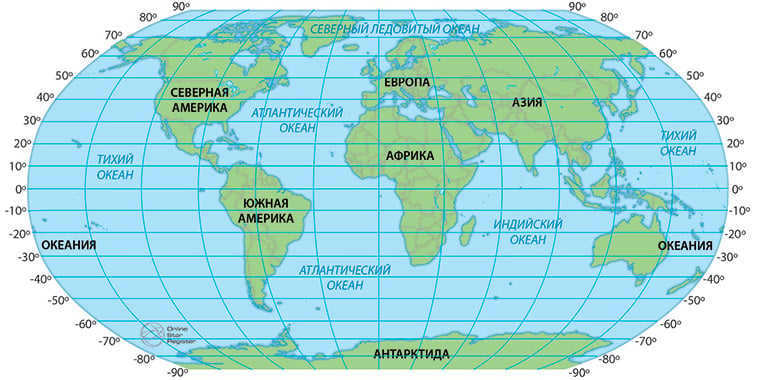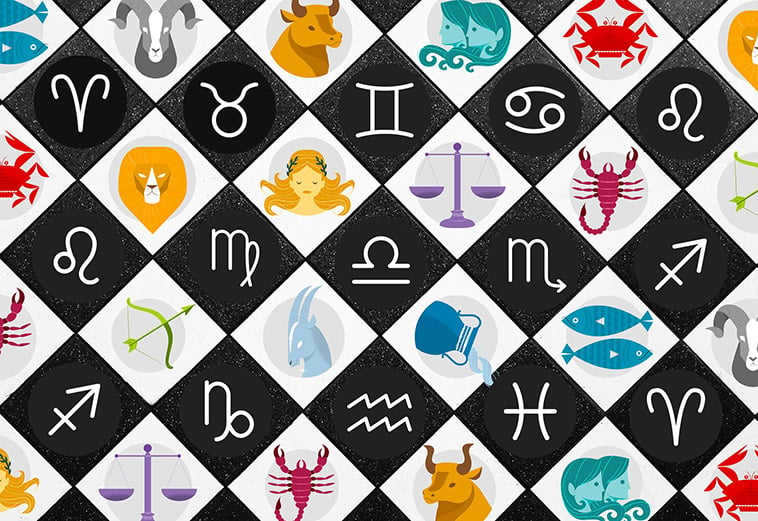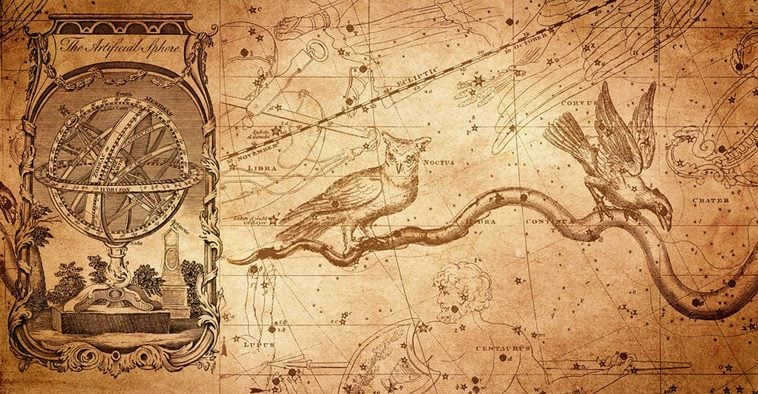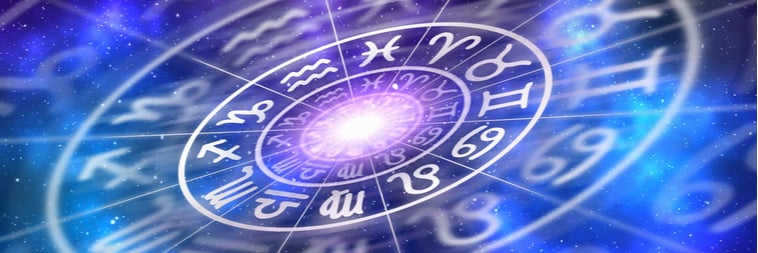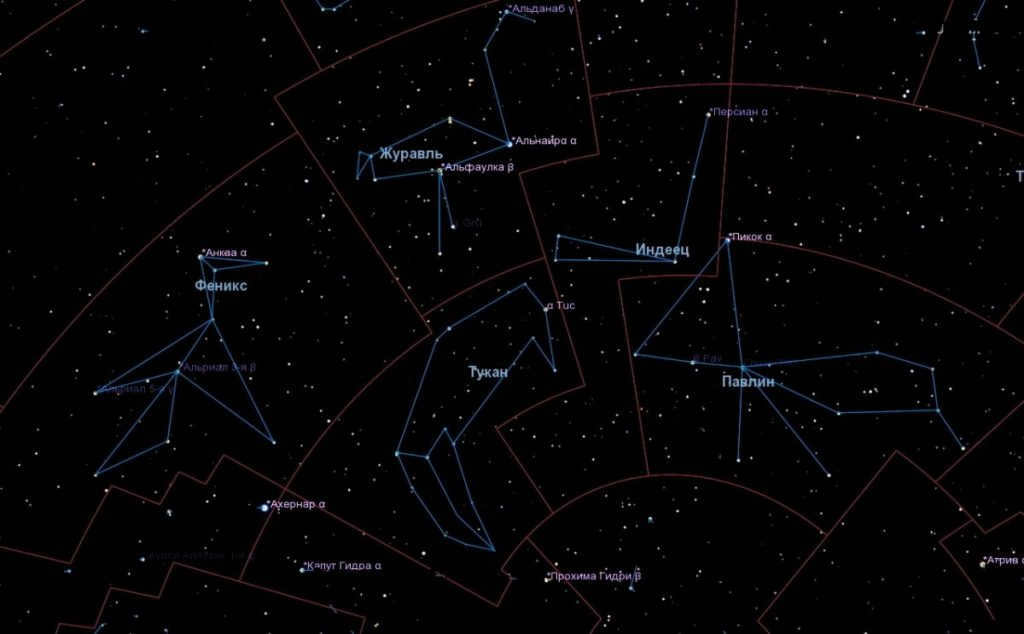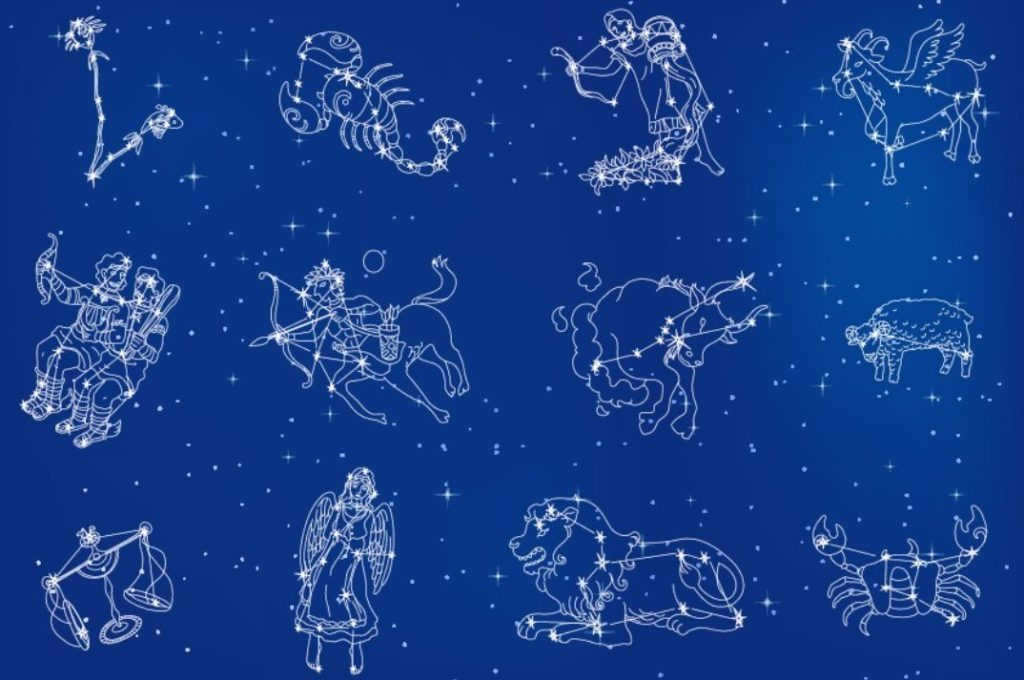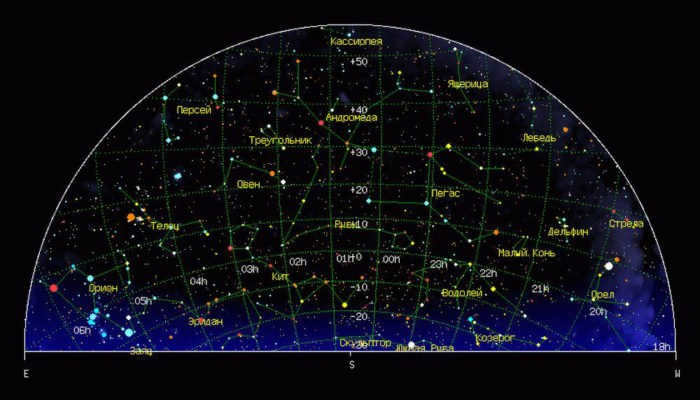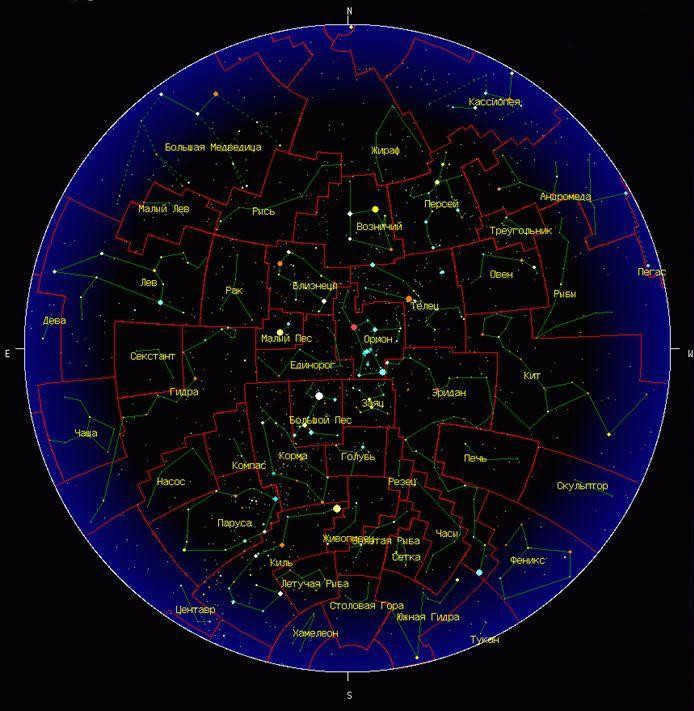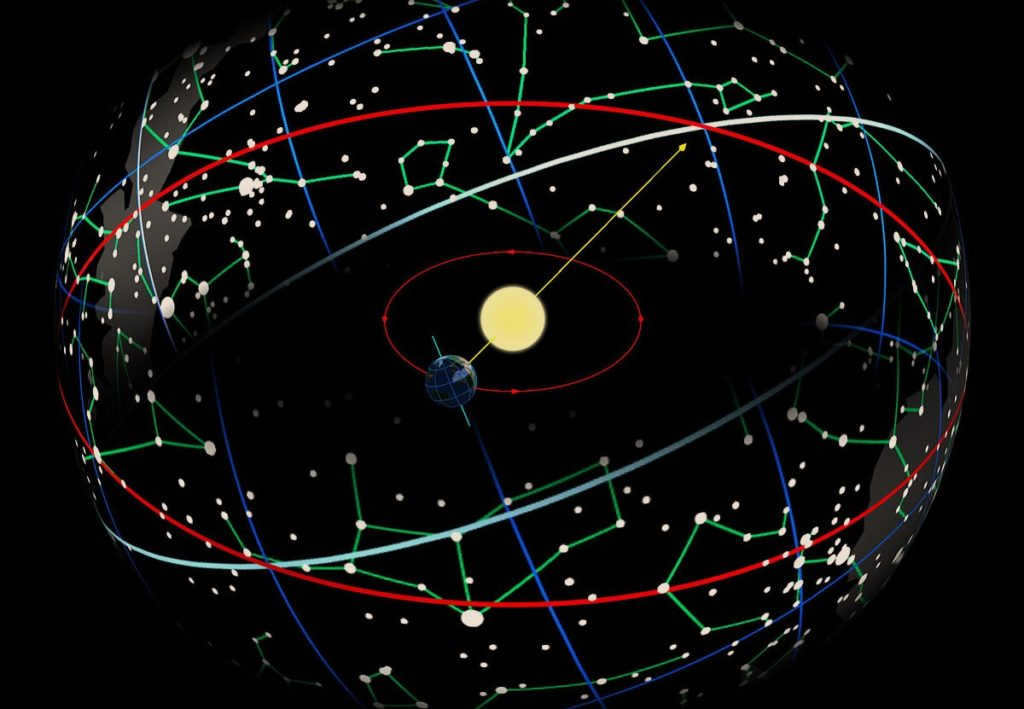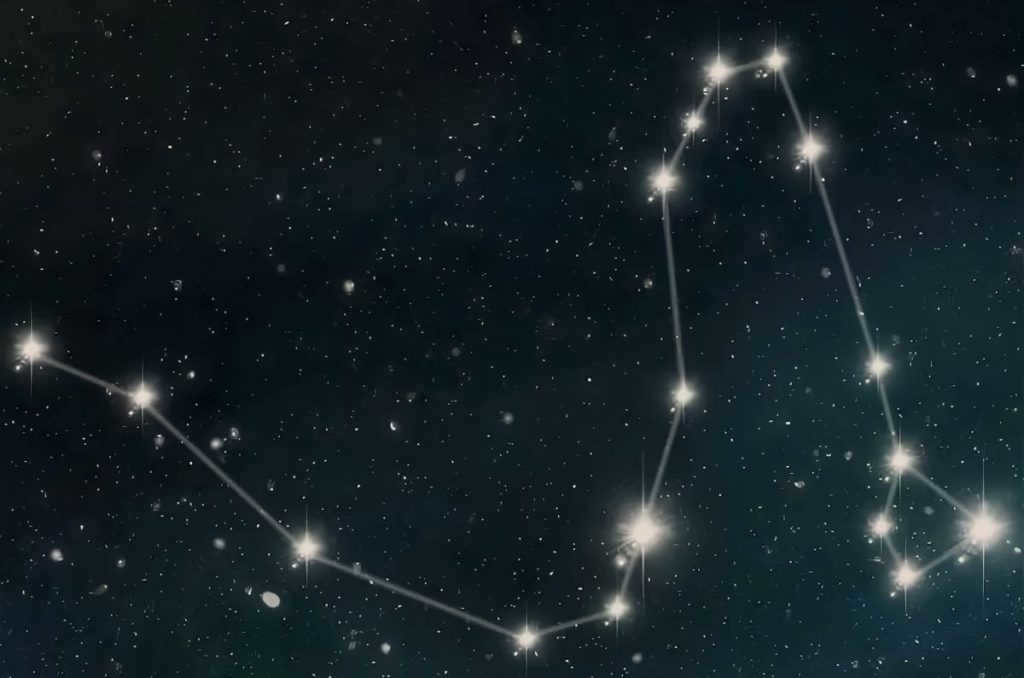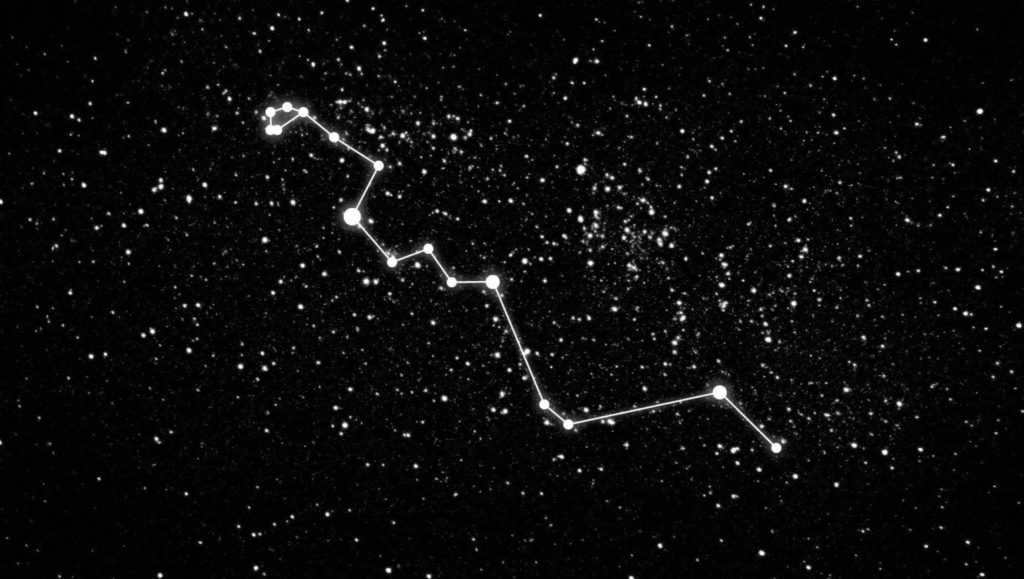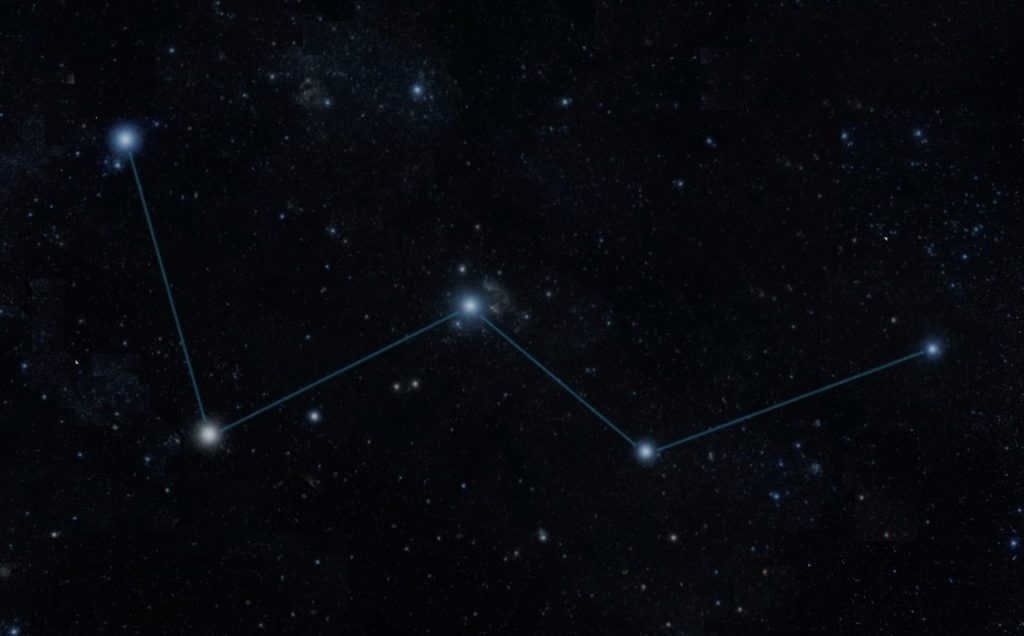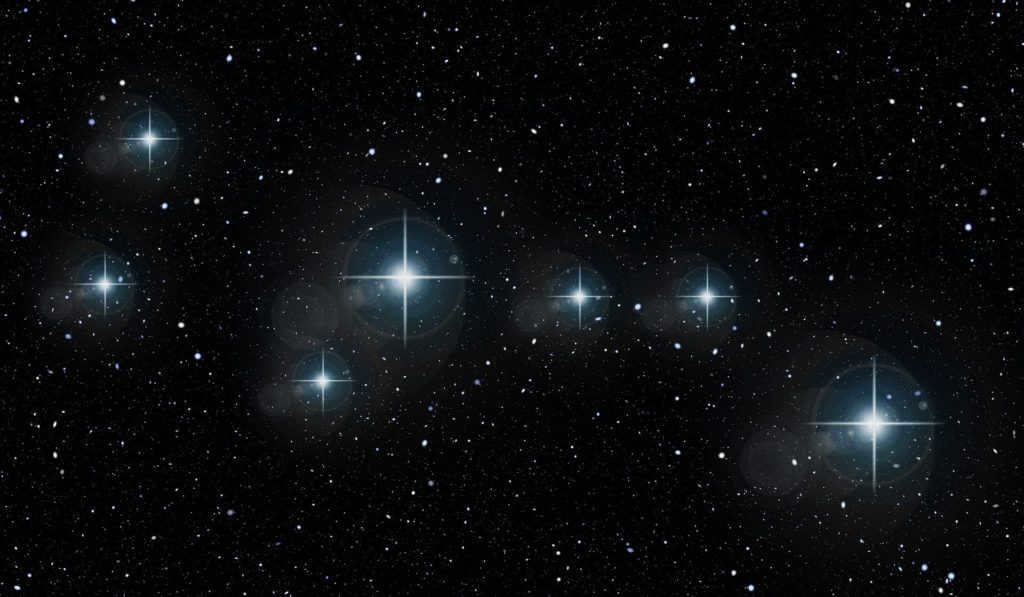Constellations are fictional illustrations in the celestial sphere created by poets, farmers, and astronomers. They have been inventing and using shapes that are familiar to us for the past 6,000 years. The primary purpose of constellations is to quickly indicate the position and characteristics of a star. On a completely dark night, it is possible to observe around 1000-1500 stars. However, how can one identify what they are looking at? This is where the brightest constellations come into play, dividing the sky into recognizable sections. For instance, if you spot three prominent stars, you will realize that you are observing a portion of Orion. From there, it becomes a matter of memorization, as Betelgeuse is hidden in the left shoulder and Rigel in the leg. In close proximity, you will also notice the Canis Major constellation and its stars. Utilize the provided charts and maps of the constellations, which include names, brightest stars, and their locations in the sky. Additionally, each constellation is accompanied by photos, illustrations, and intriguing facts. Lastly, do not forget to take into account the zodiac constellations in the starry sky.
Maps of the night sky and charts of constellations
For those captivated by the vastness of the universe, the most recent maps of the night sky, charts of constellations, and their online counterparts can be immensely helpful. Moreover, it might be worth exploring software and services that enable you to embark on cosmic journeys on a universal level.
Asterisms
In order to facilitate the recognition and memorization of the observed constellations in the night sky from the northern hemisphere, asterisms are used. Asterisms are shapes formed within the constellations and alternative names are often assigned to them. This practice makes it easier for people to remember and identify the constellations. For example, within the constellation of Ursa Major, there is the well-known asterism called the Big Dipper, which resembles a big bucket. Similarly, within the constellation of Ursa Minor, there is the Little Dipper, also known as the Little Bucket. Below, we provide descriptions of some of the most popular asterisms.
Each of the constellations in the vicinity are arranged by month, meaning that their highest level of visibility in the sky is entirely dependent on the season. As a result, when categorizing them, they are grouped according to the four seasons (winter, spring, summer, and autumn). The key thing to remember is this: if you are following the constellations strictly based on the calendar, you should begin at 9:00 PM. If you are observing earlier, you should subtract half a month, and if you start after 9:00 PM, you should add half a month.
For the sake of easy navigation, we have organized the names of all the constellations in alphabetical order. This is particularly helpful if you have a specific constellation in mind. Please note that the diagrams only display the brightest stars. To delve deeper into the subject, you will need to refer to a star map or a planisphere – a portable version. You can find more fascinating information about constellations in our articles:
If you want to immerse yourself in the mesmerizing expanse of the universe, we have curated a compilation of the most extraordinary visuals and photographs showcasing renowned constellations.
Winter, Spring, Summer, and Fall Skies: A Celestial Symphony
Alphabetical Index: A Stargazer’s Guide to the Heavens
| Little Canine | Canis Minor | CMi | 183 | 20 |
| Microscope | Microscopium | Mic | 210 | 20 |
| Insect | Musca | Mus | 138 | 30 |
| Antlia | Pump | Ant | 239 | 20 |
| Naugolnik | Norma | Nor | 165 | 20 |
| Ram | Aries | Ari | 441 | 50 |
| Octant | Octans | Oct | 291 | 35 |
| Eagle | Aquila | Aql | 652 | 70 |
| Orion | Orion | Ori | 594 | 120 |
| Peacock | Pavo | Pav | 378 | 45 |
| Sails | Vela | Vel | 500 | 110 |
| Pegasus | Pegasus | Peg | 1121 | 100 |
| Perseus | Perseus | Per | 615 | 90 |
| Furnace | Fornax | For | 398 | 35 |
| Bird of Paradise | Apus | Aps | 206 | 20 |
| Cancer | Cancer | Cnc | 506 | 60 |
| Incisor | Caelum | Cae | 125 | 10 |
| Pisces | Pisces | Psc | 889 | 75 |
| Lynx | Lynx | Lyn | 545 | 60 |
| Northern Crown | Corona Borealis | CrB | 179 | 20 |
| Sextant | Sextans | Sex | 314 | 25 |
| Reticulum | Reticulum | Ret | 114 | 15 |
| Scorpion | Scorpius | Sco | 497 | 100 |
| Sculptor | Sculptor | Scl | 475 | 30 |
| Table Mountain | Mensa | Men | 153 | 15 |
| Arrow | Sagitta | Sge | 80 | 20 |
| Sagittarius | Sagittarius | Sgr | 867 | 115 |
| Telescope | Telescopium | Tel | 252 | 30 |
| Taurus | Taurus | Tau | 797 | 125 |
| Triangle | Triangulum | Tri | 132 | 15 |
| Tucana | Tucana | Tuc | 295 | 25 |
| Phoenix | Phoenix | Phe | 469 | 40 |
| Chameleon | Chamaeleon | Cha | 132 | 20 |
| Centaurus (Centaurus) | Centaurus | Cen | 1060 | 150 |
| Cepheus | Cepheus | Cep | 588 | 60 |
| Circinus | Circinus | Cir | 93 | 20 |
| Horologium | Clock | Hor | 249 | 20 |
| Cup | Crater | Crt | 282 | 20 |
| Shield | Scutum | Sct | 109 | 20 |
| Eridanus | Eridanus | Eri | 1138 | 100 |
| Southern Hydra | Hydrus | Hyi | 243 | 20 |
| Southern Corona | Corona Australis | CrA | 128 | 25 |
| Southern Fish | Piscis Austrinus | PsA | 245 | 25 |
| Southern Cross | Crux | Cru | 68 | 30 |
| Southern Triangle | Triangulum Australe | TrA | 110 | 20 |
| Lizard | Lacerta | Lac | 201 | 35 |
The constellations were not clearly defined until the 20th century. In total, there are 88 constellations, but 48 of them are based on the Greek ones described by Ptolemy in the 2nd century. The final organization was established in 1922 with the assistance of American astronomer Henry Norris Russell. The boundaries of the constellations were officially established in 1930 by Belgian astronomer Eugene Delport, using vertical and horizontal lines.
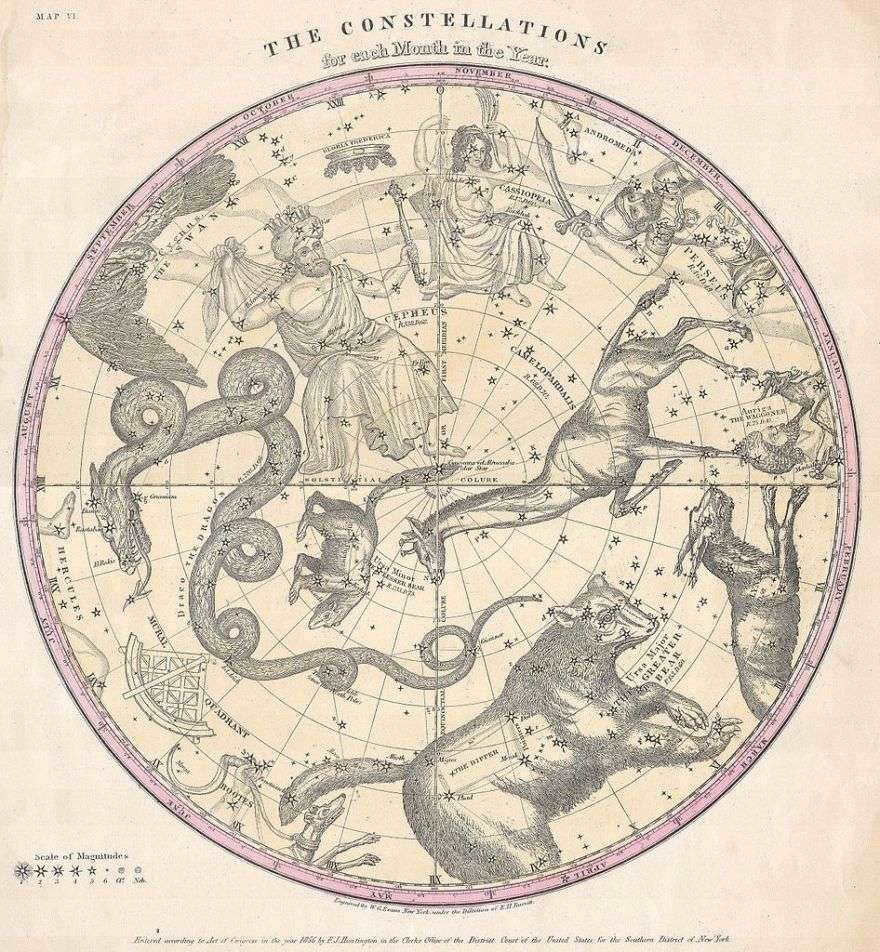

Constellations corresponding to each month in the year 1856 are showcased in this exceptional color map of the northern hemisphere, which was meticulously crafted by W. J. Evans. The constellations are portrayed with great precision and include representations of zodiacal figures. Notably, the map highlights the presence of prominent constellations like the Big Dipper, Little Dipper, Dragon, Perseus, Cassiopeia, Giraffe, and Cepheus.
Many constellations still bear the names of their ancient predecessors, with 50 originating from Rome, Greece, and the Middle East, while 38 are more modern creations. However, the concept of constellations has evolved over time, with different cultures contributing and shaping the celestial patterns. This has resulted in some constellations disappearing and new ones being introduced. For instance, the Wall Quadrant constellation was established in 1795 but later split into the Dragon and Volopas constellations.
An example of this cultural influence can be seen with the Greek constellation known as the Ship of Argo. It was originally classified as a single constellation but was later divided by Nicholas Louis de Lacay into the Keel, Sails, and Stern constellations. This division was officially recorded in 1763.
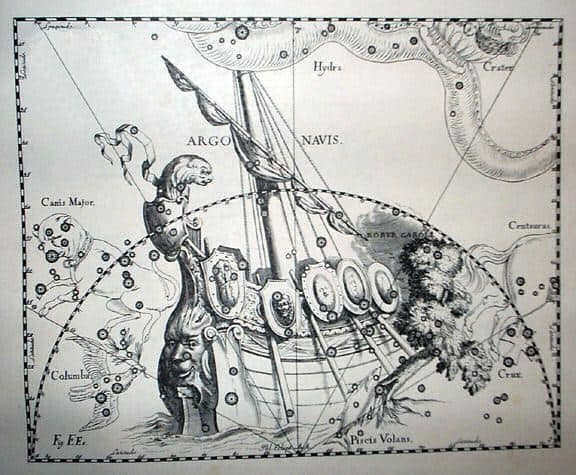
The constellation Ship of Argo (1690).
When scientists refer to stars and objects, they mean that these celestial bodies are located within the boundaries of these constellations. However, it is important to note that the constellations themselves are not tangible entities, as in reality, all stars and nebulae are incredibly distant and even flat (although from our perspective on Earth, they appear as flat lines).
Furthermore, the vast distances between these celestial bodies also introduce a time delay, as we are observing them in the past. This means that their current appearance may be quite different from what we see. For instance, Antares in the constellation Scorpius is located approximately 550 light-years away from us, which is why we perceive it as it appeared in the past. The same is true for the three-dimensional Sagittarius Nebula, which is situated around 5200 light-years away. And then there are even more distant objects, such as NGC 4038 in the constellation Raven, which is located approximately 45 million light-years away.
What is a Constellation?
A constellation is a unique pattern formed by a group of stars. It can also refer to any of the 88 official configurations that have been cataloged. Some dictionaries define a constellation as a specific grouping of stars that represents a figure in the sky and has a designated name.
The Origins of Constellations
In ancient times, people would gaze at the night sky and identify shapes resembling animals and legendary heroes. They would invent stories and myths about these figures to help them remember the positions of the stars.
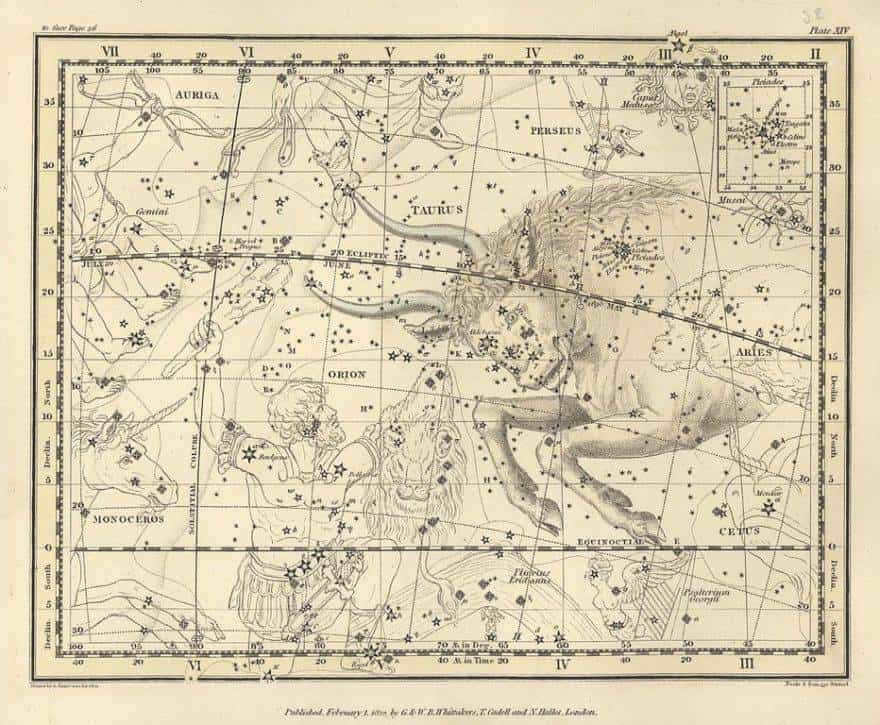
Orion and Taurus. This plate comprises 13 cards.
As an illustration, Orion and Taurus have been revered by various civilizations for countless centuries and possess a multitude of legends. When astronomers started crafting the first maps, they took advantage of the pre-existing myths.
The term constellation is derived from the Latin constellātiō, which means “a multitude with stars”. According to Ammianus Marcellinus, a Roman soldier and historian, it began to be used in the 4th century. It entered the English language in the 14th century and initially referred to planetary unions. It was only in the mid-16th century that it started to acquire its modern meaning.
The Greeks incorporated Babylonian astronomy into their own, resulting in the constellations becoming intertwined and merging together. Numerous constellations were unable to be identified by the Greeks, Babylonians, Arabs, or Chinese due to their lack of visibility. In the late 16th century, Dutch navigators Federico de Houtman and Pieter Dirkszoon Keyser documented the southern constellations. These constellations were subsequently added to Johannes Bayer’s star atlas Uranometria (1603).
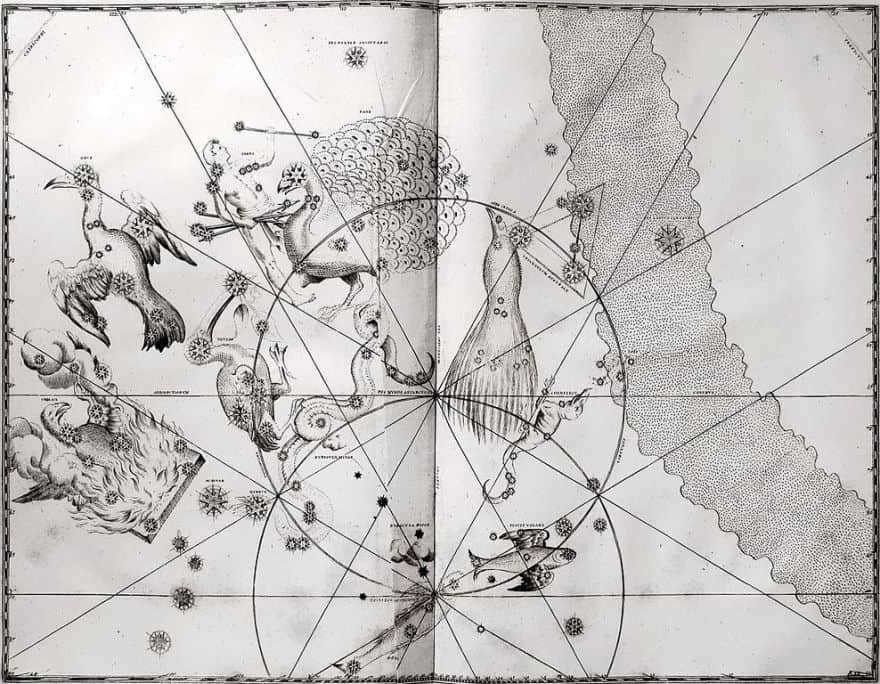

Johann Bayer’s Uranometria engraving depicts the newly discovered constellations in the southern hemisphere.
Bayer introduced 11 new constellations, which include Toucan, Fly, Goldfish, Indian, and Phoenix. Furthermore, he assigned Greek letters to 1,564 stars, ranking them based on their brightness (starting with Alpha). These designations have endured over time and are among the 10,000 stars visible to the naked eye. Some stars have acquired proper names due to their exceptional brightness, such as Aldebaran, Betelgeuse, and others.
Nicholas Louis de Lacaille, a French astronomer, made a significant contribution to the field by adding several constellations to the night sky. In 1756, he published his catalog, which included his findings after scanning the southern hemisphere. Remarkably, Lacaille discovered 13 new constellations, including Octanthus, Painter, Furnace, Table Mountain, and Pump.
Out of the total 88 constellations, 36 can be observed in the northern sky, while the remaining 52 are located in the southern hemisphere.
Author’s Note
Constellations are a valuable resource when it comes to studying the stars that fill our skies. By combining them, we can appreciate the awe-inspiring wonders of the cosmos.
If you’re new to the world of amateur astronomy, understanding constellations is a crucial first step. Without this knowledge, you’ll struggle to navigate and locate celestial objects like the Andromeda galaxy. It may seem daunting at first, but it’s definitely achievable.
The vast expanse of space has captivated human beings for centuries, continuously revealing its incredible diversity and breathtaking beauty. Among the many wonders that grace the celestial sphere, constellations stand out as particularly extraordinary. These clusters of stars, each shining with its own unique brightness and size, serve as timeless navigational beacons, connecting people of today with the same awe-inspiring constellations that guided the likes of Ptolemy, Leonardo da Vinci, and Isaac Newton.
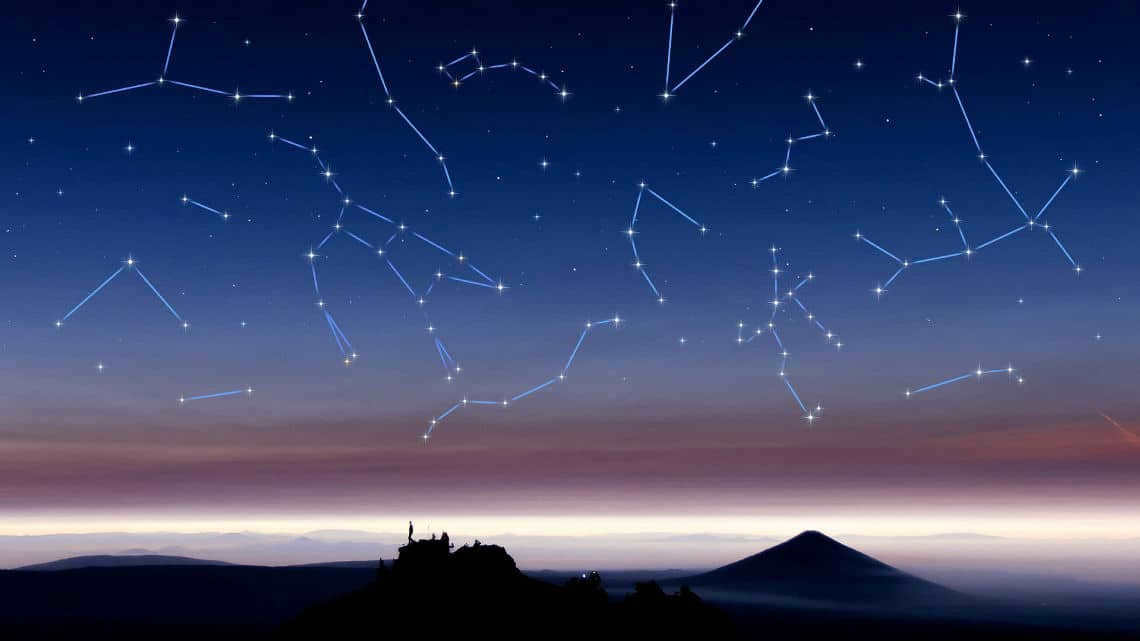
Understanding Constellations
As astronomers observed the stars, they made an intriguing discovery – the stars formed patterns and clusters. In the 17th century, these groups of stars were referred to as constellations. However, this belief was later disproven in the following centuries. Since then, constellations have been defined as specific sections of the starry sky that contain certain stars, rather than encompassing all the celestial bodies themselves.
Complete catalog of constellations
Officially, there are a total of 88 constellations, each with its own unique name, Latin abbreviation, group, and location area. While the first two points may be relatively straightforward, not many people are aware of the group and location area of each constellation.
There are only 8 groups that categorize all the areas of the starry sky: N. L. de Lacaille, Bayer, Great Bear, Water, Hercules, Zodiacal, Perseus, Orion. These groups are represented by the first three letters of their Latin names: Lac, Bay, Wat, Zod, Urs, Per, Ori, and Her.
There are two location areas – the northern region, indicated by the Latin letter “N,” and the southern region, abbreviated as “S.” Additionally, the area column also includes numbers from 1 to 4, which correspond to the squares that divide the constellation map.
| № | Name | Short name in Latin | Group | Area of location | |||||||||||||||||||||||||||||||||||||||||||||||||||||||||||||||||||||||||||||||||||||||||||||||||||||||||||||||||||||||||||||||||||||||||||||||||||||||||||||||||||||||||||||||||||||||||||||||||||||||||||||||||||||||||||||||||||||||||||||||||||||||||||||||||||||||||||||||||||||||||||||||||||||||||||||||||||||||||||||||||||||||||||||||||||||||||||||
| 1 | Andromeda | And | Her | NQ1 | |||||||||||||||||||||||||||||||||||||||||||||||||||||||||||||||||||||||||||||||||||||||||||||||||||||||||||||||||||||||||||||||||||||||||||||||||||||||||||||||||||||||||||||||||||||||||||||||||||||||||||||||||||||||||||||||||||||||||||||||||||||||||||||||||||||||||||||||||||||||||||||||||||||||||||||||||||||||||||||||||||||||||||||||||||||||||||||
| 2 | Virgo | Vir | Zod | SQ3 | |||||||||||||||||||||||||||||||||||||||||||||||||||||||||||||||||||||||||||||||||||||||||||||||||||||||||||||||||||||||||||||||||||||||||||||||||||||||||||||||||||||||||||||||||||||||||||||||||||||||||||||||||||||||||||||||||||||||||||||||||||||||||||||||||||||||||||||||||||||||||||||||||||||||||||||||||||||||||||||||||||||||||||||||||||||||||||||
| 3 | Hydra | Hya | Her | SQ2 | |||||||||||||||||||||||||||||||||||||||||||||||||||||||||||||||||||||||||||||||||||||||||||||||||||||||||||||||||||||||||||||||||||||||||||||||||||||||||||||||||||||||||||||||||||||||||||||||||||||||||||||||||||||||||||||||||||||||||||||||||||||||||||||||||||||||||||||||||||||||||||||||||||||||||||||||||||||||||||||||||||||||||||||||||||||||||||||
| 4 | Big Dipper | Uma | Urs | NQ2 | |||||||||||||||||||||||||||||||||||||||||||||||||||||||||||||||||||||||||||||||||||||||||||||||||||||||||||||||||||||||||||||||||||||||||||||||||||||||||||||||||||||||||||||||||||||||||||||||||||||||||||||||||||||||||||||||||||||||||||||||||||||||||||||||||||||||||||||||||||||||||||||||||||||||||||||||||||||||||||||||||||||||||||||||||||||||||||||
| 5 | Little Bear | Umi | Urs | NQ3 | |||||||||||||||||||||||||||||||||||||||||||||||||||||||||||||||||||||||||||||||||||||||||||||||||||||||||||||||||||||||||||||||||||||||||||||||||||||||||||||||||||||||||||||||||||||||||||||||||||||||||||||||||||||||||||||||||||||||||||||||||||||||||||||||||||||||||||||||||||||||||||||||||||||||||||||||||||||||||||||||||||||||||||||||||||||||||||||
| 6 | Cetus | Cet | Per | SQ1 | |||||||||||||||||||||||||||||||||||||||||||||||||||||||||||||||||||||||||||||||||||||||||||||||||||||||||||||||||||||||||||||||||||||||||||||||||||||||||||||||||||||||||||||||||||||||||||||||||||||||||||||||||||||||||||||||||||||||||||||||||||||||||||||||||||||||||||||||||||||||||||||||||||||||||||||||||||||||||||||||||||||||||||||||||||||||||||||
| 7 | Hercules | Her | Her | NQ3 | |||||||||||||||||||||||||||||||||||||||||||||||||||||||||||||||||||||||||||||||||||||||||||||||||||||||||||||||||||||||||||||||||||||||||||||||||||||||||||||||||||||||||||||||||||||||||||||||||||||||||||||||||||||||||||||||||||||||||||||||||||||||||||||||||||||||||||||||||||||||||||||||||||||||||||||||||||||||||||||||||||||||||||||||||||||||||||||
| 8 | Pegasus | Peg | Per | NQ4 | |||||||||||||||||||||||||||||||||||||||||||||||||||||||||||||||||||||||||||||||||||||||||||||||||||||||||||||||||||||||||||||||||||||||||||||||||||||||||||||||||||||||||||||||||||||||||||||||||||||||||||||||||||||||||||||||||||||||||||||||||||||||||||||||||||||||||||||||||||||||||||||||||||||||||||||||||||||||||||||||||||||||||||||||||||||||||||||
| 9 | Eridanus | Eri | Wat | SQ1 | |||||||||||||||||||||||||||||||||||||||||||||||||||||||||||||||||||||||||||||||||||||||||||||||||||||||||||||||||||||||||||||||||||||||||||||||||||||||||||||||||||||||||||||||||||||||||||||||||||||||||||||||||||||||||||||||||||||||||||||||||||||||||||||||||||||||||||||||||||||||||||||||||||||||||||||||||||||||||||||||||||||||||||||||||||||||||||||
| 10 | Centauri | Cen | Her | SQ3 | |||||||||||||||||||||||||||||||||||||||||||||||||||||||||||||||||||||||||||||||||||||||||||||||||||||||||||||||||||||||||||||||||||||||||||||||||||||||||||||||||||||||||||||||||||||||||||||||||||||||||||||||||||||||||||||||||||||||||||||||||||||||||||||||||||||||||||||||||||||||||||||||||||||||||||||||||||||||||||||||||||||||||||||||||||||||||||||
| 11 | Leo | Leo | Zod | NQ2 | |||||||||||||||||||||||||||||||||||||||||||||||||||||||||||||||||||||||||||||||||||||||||||||||||||||||||||||||||||||||||||||||||||||||||||||||||||||||||||||||||||||||||||||||||||||||||||||||||||||||||||||||||||||||||||||||||||||||||||||||||||||||||||||||||||||||||||||||||||||||||||||||||||||||||||||||||||||||||||||||||||||||||||||||||||||||||||||
| 12 | Dragon | Dra | Urs | NQ3 | |||||||||||||||||||||||||||||||||||||||||||||||||||||||||||||||||||||||||||||||||||||||||||||||||||||||||||||||||||||||||||||||||||||||||||||||||||||||||||||||||||||||||||||||||||||||||||||||||||||||||||||||||||||||||||||||||||||||||||||||||||||||||||||||||||||||||||||||||||||||||||||||||||||||||||||||||||||||||||||||||||||||||||||||||||||||||||||
| 13 | Aquarius | Aqr | Zod | SQ4 | |||||||||||||||||||||||||||||||||||||||||||||||||||||||||||||||||||||||||||||||||||||||||||||||||||||||||||||||||||||||||||||||||||||||||||||||||||||||||||||||||||||||||||||||||||||||||||||||||||||||||||||||||||||||||||||||||||||||||||||||||||||||||||||||||||||||||||||||||||||||||||||||||||||||||||||||||||||||||||||||||||||||||||||||||||||||||||||
| 14 | Volopassus | Boo | Urs | NQ3 | |||||||||||||||||||||||||||||||||||||||||||||||||||||||||||||||||||||||||||||||||||||||||||||||||||||||||||||||||||||||||||||||||||||||||||||||||||||||||||||||||||||||||||||||||||||||||||||||||||||||||||||||||||||||||||||||||||||||||||||||||||||||||||||||||||||||||||||||||||||||||||||||||||||||||||||||||||||||||||||||||||||||||||||||||||||||||||||
| 15 | Pisces | Psc | Zod | NQ1 | |||||||||||||||||||||||||||||||||||||||||||||||||||||||||||||||||||||||||||||||||||||||||||||||||||||||||||||||||||||||||||||||||||||||||||||||||||||||||||||||||||||||||||||||||||||||||||||||||||||||||||||||||||||||||||||||||||||||||||||||||||||||||||||||||||||||||||||||||||||||||||||||||||||||||||||||||||||||||||||||||||||||||||||||||||||||||||||
| 16 | Sagittarius | Sgr | Zod | SQ4 | |||||||||||||||||||||||||||||||||||||||||||||||||||||||||||||||||||||||||||||||||||||||||||||||||||||||||||||||||||||||||||||||||||||||||||||||||||||||||||||||||||||||||||||||||||||||||||||||||||||||||||||||||||||||||||||||||||||||||||||||||||||||||||||||||||||||||||||||||||||||||||||||||||||||||||||||||||||||||||||||||||||||||||||||||||||||||||||
| 17 | Swan | Cyg | Her | NQ4 | |||||||||||||||||||||||||||||||||||||||||||||||||||||||||||||||||||||||||||||||||||||||||||||||||||||||||||||||||||||||||||||||||||||||||||||||||||||||||||||||||||||||||||||||||||||||||||||||||||||||||||||||||||||||||||||||||||||||||||||||||||||||||||||||||||||||||||||||||||||||||||||||||||||||||||||||||||||||||||||||||||||||||||||||||||||||||||||
| 18 | Taurus | Tau | Zod | NQ1 | |||||||||||||||||||||||||||||||||||||||||||||||||||||||||||||||||||||||||||||||||||||||||||||||||||||||||||||||||||||||||||||||||||||||||||||||||||||||||||||||||||||||||||||||||||||||||||||||||||||||||||||||||||||||||||||||||||||||||||||||||||||||||||||||||||||||||||||||||||||||||||||||||||||||||||||||||||||||||||||||||||||||||||||||||||||||||||||
| 19 | Giraffe | Cam | Urs | NQ2 | |||||||||||||||||||||||||||||||||||||||||||||||||||||||||||||||||||||||||||||||||||||||||||||||||||||||||||||||||||||||||||||||||||||||||||||||||||||||||||||||||||||||||||||||||||||||||||||||||||||||||||||||||||||||||||||||||||||||||||||||||||||||||||||||||||||||||||||||||||||||||||||||||||||||||||||||||||||||||||||||||||||||||||||||||||||||||||||
| 20 | Andromeda | And | Per | NQ1 | |||||||||||||||||||||||||||||||||||||||||||||||||||||||||||||||||||||||||||||||||||||||||||||||||||||||||||||||||||||||||||||||||||||||||||||||||||||||||||||||||||||||||||||||||||||||||||||||||||||||||||||||||||||||||||||||||||||||||||||||||||||||||||||||||||||||||||||||||||||||||||||||||||||||||||||||||||||||||||||||||||||||||||||||||||||||||||||
| 21 | Feed | Pup | Wat | SQ2 | |||||||||||||||||||||||||||||||||||||||||||||||||||||||||||||||||||||||||||||||||||||||||||||||||||||||||||||||||||||||||||||||||||||||||||||||||||||||||||||||||||||||||||||||||||||||||||||||||||||||||||||||||||||||||||||||||||||||||||||||||||||||||||||||||||||||||||||||||||||||||||||||||||||||||||||||||||||||||||||||||||||||||||||||||||||||||||||
| 22 | Charioteer | Aur | Per | NQ2 | |||||||||||||||||||||||||||||||||||||||||||||||||||||||||||||||||||||||||||||||||||||||||||||||||||||||||||||||||||||||||||||||||||||||||||||||||||||||||||||||||||||||||||||||||||||||||||||||||||||||||||||||||||||||||||||||||||||||||||||||||||||||||||||||||||||||||||||||||||||||||||||||||||||||||||||||||||||||||||||||||||||||||||||||||||||||||||||
| 23 | Eagle | Aql | Her | NQ4 | |||||||||||||||||||||||||||||||||||||||||||||||||||||||||||||||||||||||||||||||||||||||||||||||||||||||||||||||||||||||||||||||||||||||||||||||||||||||||||||||||||||||||||||||||||||||||||||||||||||||||||||||||||||||||||||||||||||||||||||||||||||||||||||||||||||||||||||||||||||||||||||||||||||||||||||||||||||||||||||||||||||||||||||||||||||||||||||
| 24 | Snake | Ser | Her | NQ3 | |||||||||||||||||||||||||||||||||||||||||||||||||||||||||||||||||||||||||||||||||||||||||||||||||||||||||||||||||||||||||||||||||||||||||||||||||||||||||||||||||||||||||||||||||||||||||||||||||||||||||||||||||||||||||||||||||||||||||||||||||||||||||||||||||||||||||||||||||||||||||||||||||||||||||||||||||||||||||||||||||||||||||||||||||||||||||||||
| 25 | Perseus | Per | Per | NQ1 | |||||||||||||||||||||||||||||||||||||||||||||||||||||||||||||||||||||||||||||||||||||||||||||||||||||||||||||||||||||||||||||||||||||||||||||||||||||||||||||||||||||||||||||||||||||||||||||||||||||||||||||||||||||||||||||||||||||||||||||||||||||||||||||||||||||||||||||||||||||||||||||||||||||||||||||||||||||||||||||||||||||||||||||||||||||||||||||
| 26 | Cassiopeia | Cas | Per | NQ1 | |||||||||||||||||||||||||||||||||||||||||||||||||||||||||||||||||||||||||||||||||||||||||||||||||||||||||||||||||||||||||||||||||||||||||||||||||||||||||||||||||||||||||||||||||||||||||||||||||||||||||||||||||||||||||||||||||||||||||||||||||||||||||||||||||||||||||||||||||||||||||||||||||||||||||||||||||||||||||||||||||||||||||||||||||||||||||||||
| 27 | Orion | Ori | Ori | NQ1 | |||||||||||||||||||||||||||||||||||||||||||||||||||||||||||||||||||||||||||||||||||||||||||||||||||||||||||||||||||||||||||||||||||||||||||||||||||||||||||||||||||||||||||||||||||||||||||||||||||||||||||||||||||||||||||||||||||||||||||||||||||||||||||||||||||||||||||||||||||||||||||||||||||||||||||||||||||||||||||||||||||||||||||||||||||||||||||||
| 28 | Cepheus | Cer | Per | NQ4 | |||||||||||||||||||||||||||||||||||||||||||||||||||||||||||||||||||||||||||||||||||||||||||||||||||||||||||||||||||||||||||||||||||||||||||||||||||||||||||||||||||||||||||||||||||||||||||||||||||||||||||||||||||||||||||||||||||||||||||||||||||||||||||||||||||||||||||||||||||||||||||||||||||||||||||||||||||||||||||||||||||||||||||||||||||||||||||||
| 29 | Lynx | Lyn | Urs | NQ2 | |||||||||||||||||||||||||||||||||||||||||||||||||||||||||||||||||||||||||||||||||||||||||||||||||||||||||||||||||||||||||||||||||||||||||||||||||||||||||||||||||||||||||||||||||||||||||||||||||||||||||||||||||||||||||||||||||||||||||||||||||||||||||||||||||||||||||||||||||||||||||||||||||||||||||||||||||||||||||||||||||||||||||||||||||||||||||||||
| 30 | Libra | Lib | Zod | SQ3 | |||||||||||||||||||||||||||||||||||||||||||||||||||||||||||||||||||||||||||||||||||||||||||||||||||||||||||||||||||||||||||||||||||||||||||||||||||||||||||||||||||||||||||||||||||||||||||||||||||||||||||||||||||||||||||||||||||||||||||||||||||||||||||||||||||||||||||||||||||||||||||||||||||||||||||||||||||||||||||||||||||||||||||||||||||||||||||||
| 31 | Gemini | Gem | Zod | NQ2 | |||||||||||||||||||||||||||||||||||||||||||||||||||||||||||||||||||||||||||||||||||||||||||||||||||||||||||||||||||||||||||||||||||||||||||||||||||||||||||||||||||||||||||||||||||||||||||||||||||||||||||||||||||||||||||||||||||||||||||||||||||||||||||||||||||||||||||||||||||||||||||||||||||||||||||||||||||||||||||||||||||||||||||||||||||||||||||||
| 32 | Cancer | Cnc | Zod | NQ2 | |||||||||||||||||||||||||||||||||||||||||||||||||||||||||||||||||||||||||||||||||||||||||||||||||||||||||||||||||||||||||||||||||||||||||||||||||||||||||||||||||||||||||||||||||||||||||||||||||||||||||||||||||||||||||||||||||||||||||||||||||||||||||||||||||||||||||||||||||||||||||||||||||||||||||||||||||||||||||||||||||||||||||||||||||||||||||||||
| 33 | Sails | Vel | Wat | SQ2 | |||||||||||||||||||||||||||||||||||||||||||||||||||||||||||||||||||||||||||||||||||||||||||||||||||||||||||||||||||||||||||||||||||||||||||||||||||||||||||||||||||||||||||||||||||||||||||||||||||||||||||||||||||||||||||||||||||||||||||||||||||||||||||||||||||||||||||||||||||||||||||||||||||||||||||||||||||||||||||||||||||||||||||||||||||||||||||||
| 34 | Scorpion | Sco | Zod | SQ3 | |||||||||||||||||||||||||||||||||||||||||||||||||||||||||||||||||||||||||||||||||||||||||||||||||||||||||||||||||||||||||||||||||||||||||||||||||||||||||||||||||||||||||||||||||||||||||||||||||||||||||||||||||||||||||||||||||||||||||||||||||||||||||||||||||||||||||||||||||||||||||||||||||||||||||||||||||||||||||||||||||||||||||||||||||||||||||||||
| 35 | Keel | Car | Wat | SQ2 | |||||||||||||||||||||||||||||||||||||||||||||||||||||||||||||||||||||||||||||||||||||||||||||||||||||||||||||||||||||||||||||||||||||||||||||||||||||||||||||||||||||||||||||||||||||||||||||||||||||||||||||||||||||||||||||||||||||||||||||||||||||||||||||||||||||||||||||||||||||||||||||||||||||||||||||||||||||||||||||||||||||||||||||||||||||||||||||
| 36 | Unicorn | Mon | Ori | NQ2 | |||||||||||||||||||||||||||||||||||||||||||||||||||||||||||||||||||||||||||||||||||||||||||||||||||||||||||||||||||||||||||||||||||||||||||||||||||||||||||||||||||||||||||||||||||||||||||||||||||||||||||||||||||||||||||||||||||||||||||||||||||||||||||||||||||||||||||||||||||||||||||||||||||||||||||||||||||||||||||||||||||||||||||||||||||||||||||||
| 37 | Sculptor | Scl | Lac | SQ1 | |||||||||||||||||||||||||||||||||||||||||||||||||||||||||||||||||||||||||||||||||||||||||||||||||||||||||||||||||||||||||||||||||||||||||||||||||||||||||||||||||||||||||||||||||||||||||||||||||||||||||||||||||||||||||||||||||||||||||||||||||||||||||||||||||||||||||||||||||||||||||||||||||||||||||||||||||||||||||||||||||||||||||||||||||||||||||||||
| 38 | Phoenix | Phe | Bay | SQ1 | |||||||||||||||||||||||||||||||||||||||||||||||||||||||||||||||||||||||||||||||||||||||||||||||||||||||||||||||||||||||||||||||||||||||||||||||||||||||||||||||||||||||||||||||||||||||||||||||||||||||||||||||||||||||||||||||||||||||||||||||||||||||||||||||||||||||||||||||||||||||||||||||||||||||||||||||||||||||||||||||||||||||||||||||||||||||||||||
| 39 | Hound Dogs | Cvn | Urs | NQ3 | |||||||||||||||||||||||||||||||||||||||||||||||||||||||||||||||||||||||||||||||||||||||||||||||||||||||||||||||||||||||||||||||||||||||||||||||||||||||||||||||||||||||||||||||||||||||||||||||||||||||||||||||||||||||||||||||||||||||||||||||||||||||||||||||||||||||||||||||||||||||||||||||||||||||||||||||||||||||||||||||||||||||||||||||||||||||||||||
| 40 | Aries | Ari | Zod | NQ1 | |||||||||||||||||||||||||||||||||||||||||||||||||||||||||||||||||||||||||||||||||||||||||||||||||||||||||||||||||||||||||||||||||||||||||||||||||||||||||||||||||||||||||||||||||||||||||||||||||||||||||||||||||||||||||||||||||||||||||||||||||||||||||||||||||||||||||||||||||||||||||||||||||||||||||||||||||||||||||||||||||||||||||||||||||||||||||||||
| 41 | Capricorn | Cap | Zod | SQ4 | |||||||||||||||||||||||||||||||||||||||||||||||||||||||||||||||||||||||||||||||||||||||||||||||||||||||||||||||||||||||||||||||||||||||||||||||||||||||||||||||||||||||||||||||||||||||||||||||||||||||||||||||||||||||||||||||||||||||||||||||||||||||||||||||||||||||||||||||||||||||||||||||||||||||||||||||||||||||||||||||||||||||||||||||||||||||||||||
| 42 | Furnace | For | Lac | SQ1 | |||||||||||||||||||||||||||||||||||||||||||||||||||||||||||||||||||||||||||||||||||||||||||||||||||||||||||||||||||||||||||||||||||||||||||||||||||||||||||||||||||||||||||||||||||||||||||||||||||||||||||||||||||||||||||||||||||||||||||||||||||||||||||||||||||||||||||||||||||||||||||||||||||||||||||||||||||||||||||||||||||||||||||||||||||||||||||||
| 43 | Veronica’s Hair | Com | Urs | NQ3 | |||||||||||||||||||||||||||||||||||||||||||||||||||||||||||||||||||||||||||||||||||||||||||||||||||||||||||||||||||||||||||||||||||||||||||||||||||||||||||||||||||||||||||||||||||||||||||||||||||||||||||||||||||||||||||||||||||||||||||||||||||||||||||||||||||||||||||||||||||||||||||||||||||||||||||||||||||||||||||||||||||||||||||||||||||||||||||||
| 44 | Big dog | Cma | Ori | SQ2 | |||||||||||||||||||||||||||||||||||||||||||||||||||||||||||||||||||||||||||||||||||||||||||||||||||||||||||||||||||||||||||||||||||||||||||||||||||||||||||||||||||||||||||||||||||||||||||||||||||||||||||||||||||||||||||||||||||||||||||||||||||||||||||||||||||||||||||||||||||||||||||||||||||||||||||||||||||||||||||||||||||||||||||||||||||||||||||||
| 45 | Peacock | Pav | Bay | SQ4 | |||||||||||||||||||||||||||||||||||||||||||||||||||||||||||||||||||||||||||||||||||||||||||||||||||||||||||||||||||||||||||||||||||||||||||||||||||||||||||||||||||||||||||||||||||||||||||||||||||||||||||||||||||||||||||||||||||||||||||||||||||||||||||||||||||||||||||||||||||||||||||||||||||||||||||||||||||||||||||||||||||||||||||||||||||||||||||||
| 46 | Crane | Gru | Bay | SQ4 | |||||||||||||||||||||||||||||||||||||||||||||||||||||||||||||||||||||||||||||||||||||||||||||||||||||||||||||||||||||||||||||||||||||||||||||||||||||||||||||||||||||||||||||||||||||||||||||||||||||||||||||||||||||||||||||||||||||||||||||||||||||||||||||||||||||||||||||||||||||||||||||||||||||||||||||||||||||||||||||||||||||||||||||||||||||||||||||
| 47 | Wolf | Lup | Her | SQ3 | |||||||||||||||||||||||||||||||||||||||||||||||||||||||||||||||||||||||||||||||||||||||||||||||||||||||||||||||||||||||||||||||||||||||||||||||||||||||||||||||||||||||||||||||||||||||||||||||||||||||||||||||||||||||||||||||||||||||||||||||||||||||||||||||||||||||||||||||||||||||||||||||||||||||||||||||||||||||||||||||||||||||||||||||||||||||||||||
| 48 | Sextant | Sex | Her | SQ2 | |||||||||||||||||||||||||||||||||||||||||||||||||||||||||||||||||||||||||||||||||||||||||||||||||||||||||||||||||||||||||||||||||||||||||||||||||||||||||||||||||||||||||||||||||||||||||||||||||||||||||||||||||||||||||||||||||||||||||||||||||||||||||||||||||||||||||||||||||||||||||||||||||||||||||||||||||||||||||||||||||||||||||||||||||||||||||||||
| 49 | Tucan | Tuc | Bay | SQ4 | |||||||||||||||||||||||||||||||||||||||||||||||||||||||||||||||||||||||||||||||||||||||||||||||||||||||||||||||||||||||||||||||||||||||||||||||||||||||||||||||||||||||||||||||||||||||||||||||||||||||||||||||||||||||||||||||||||||||||||||||||||||||||||||||||||||||||||||||||||||||||||||||||||||||||||||||||||||||||||||||||||||||||||||||||||||||||||||
| 50 | Indian | Ind | Bay | SQ4 | |||||||||||||||||||||||||||||||||||||||||||||||||||||||||||||||||||||||||||||||||||||||||||||||||||||||||||||||||||||||||||||||||||||||||||||||||||||||||||||||||||||||||||||||||||||||||||||||||||||||||||||||||||||||||||||||||||||||||||||||||||||||||||||||||||||||||||||||||||||||||||||||||||||||||||||||||||||||||||||||||||||||||||||||||||||||||||||
| 51 | Octant | Oct | Lac | SQ4 | |||||||||||||||||||||||||||||||||||||||||||||||||||||||||||||||||||||||||||||||||||||||||||||||||||||||||||||||||||||||||||||||||||||||||||||||||||||||||||||||||||||||||||||||||||||||||||||||||||||||||||||||||||||||||||||||||||||||||||||||||||||||||||||||||||||||||||||||||||||||||||||||||||||||||||||||||||||||||||||||||||||||||||||||||||||||||||||
| 52 | Hare | Lep | Ori | SQ1 | |||||||||||||||||||||||||||||||||||||||||||||||||||||||||||||||||||||||||||||||||||||||||||||||||||||||||||||||||||||||||||||||||||||||||||||||||||||||||||||||||||||||||||||||||||||||||||||||||||||||||||||||||||||||||||||||||||||||||||||||||||||||||||||||||||||||||||||||||||||||||||||||||||||||||||||||||||||||||||||||||||||||||||||||||||||||||||||
| 53 | Lyra | Lyp | Her | NQ4 | |||||||||||||||||||||||||||||||||||||||||||||||||||||||||||||||||||||||||||||||||||||||||||||||||||||||||||||||||||||||||||||||||||||||||||||||||||||||||||||||||||||||||||||||||||||||||||||||||||||||||||||||||||||||||||||||||||||||||||||||||||||||||||||||||||||||||||||||||||||||||||||||||||||||||||||||||||||||||||||||||||||||||||||||||||||||||||||
| 54 | Cup | Crt | Her | SQ2 | |||||||||||||||||||||||||||||||||||||||||||||||||||||||||||||||||||||||||||||||||||||||||||||||||||||||||||||||||||||||||||||||||||||||||||||||||||||||||||||||||||||||||||||||||||||||||||||||||||||||||||||||||||||||||||||||||||||||||||||||||||||||||||||||||||||||||||||||||||||||||||||||||||||||||||||||||||||||||||||||||||||||||||||||||||||||||||||
| 55 | Dove | Col | Wat | SQ1 | |||||||||||||||||||||||||||||||||||||||||||||||||||||||||||||||||||||||||||||||||||||||||||||||||||||||||||||||||||||||||||||||||||||||||||||||||||||||||||||||||||||||||||||||||||||||||||||||||||||||||||||||||||||||||||||||||||||||||||||||||||||||||||||||||||||||||||||||||||||||||||||||||||||||||||||||||||||||||||||||||||||||||||||||||||||||||||||
| 56 | Fox | Vul | Her | NQ4 | |||||||||||||||||||||||||||||||||||||||||||||||||||||||||||||||||||||||||||||||||||||||||||||||||||||||||||||||||||||||||||||||||||||||||||||||||||||||||||||||||||||||||||||||||||||||||||||||||||||||||||||||||||||||||||||||||||||||||||||||||||||||||||||||||||||||||||||||||||||||||||||||||||||||||||||||||||||||||||||||||||||||||||||||||||||||||||||
| 57 | Telescope | Tel | Lac | NQ3 | |||||||||||||||||||||||||||||||||||||||||||||||||||||||||||||||||||||||||||||||||||||||||||||||||||||||||||||||||||||||||||||||||||||||||||||||||||||||||||||||||||||||||||||||||||||||||||||||||||||||||||||||||||||||||||||||||||||||||||||||||||||||||||||||||||||||||||||||||||||||||||||||||||||||||||||||||||||||||||||||||||||||||||||||||||||||||||||
| 58 | Clock | Hor | Lac | SQ4 | |||||||||||||||||||||||||||||||||||||||||||||||||||||||||||||||||||||||||||||||||||||||||||||||||||||||||||||||||||||||||||||||||||||||||||||||||||||||||||||||||||||||||||||||||||||||||||||||||||||||||||||||||||||||||||||||||||||||||||||||||||||||||||||||||||||||||||||||||||||||||||||||||||||||||||||||||||||||||||||||||||||||||||||||||||||||||||||
| 59 | Painter | Pic | Lac | SQ1 | |||||||||||||||||||||||||||||||||||||||||||||||||||||||||||||||||||||||||||||||||||||||||||||||||||||||||||||||||||||||||||||||||||||||||||||||||||||||||||||||||||||||||||||||||||||||||||||||||||||||||||||||||||||||||||||||||||||||||||||||||||||||||||||||||||||||||||||||||||||||||||||||||||||||||||||||||||||||||||||||||||||||||||||||||||||||||||||
| 60 | SouthernWhat do asterisms represent?Asterisms are visual conjunctions of stars that have historical names and are known for their brightness. They often represent objects that were significant to ancient sailors, such as the Bucket, the Cross, the Belt, as well as geometric figures like triangles and squares, such as the Winter Triangle and the Great Square. In the past, travelers and navigators used these groups of stars to orient themselves. The bright stars and imaginary lines connecting them across the celestial sphere aided people in determining their location.
The following characteristics are identified:
Asterisms typically consist of the brightest and most prominent stars within constellations, such as the Big Dipper. The individual stars within an asterism may belong to multiple constellations. What sets asterisms apart from constellations?In the late 1930s, the term “constellation” was differentiated from asterism, although they were previously used interchangeably. Nowadays, scientists categorize them based on the following criteria:
Furthermore, it is worth mentioning that in the past, the general public was more familiar with the names of asterisms rather than the 88 constellations. However, the situation has now reversed. Asterisms have become relics of the past, as people now rely on navigators or compasses rather than the stars for navigation. On the other hand, constellations have gained more attention due to people’s growing interest in outer space. How the origins of constellation names were determinedEvery constellation possesses its own unique name, which was designated by the International Astronomical Union back in 1928. The names of the regions where these celestial objects are located can be categorized into two groups based on when they were first discovered – ancient and modern. As a result, the star charts in the night sky contain names of both ancient deities from Greek and Roman mythologies as well as names of contemporary animals and birds. The ancient constellations Hercules, Orion, Cassiopeia, Centaurus, and Pegasus are widely recognized and celebrated. Ptolemy, an astronomer of the second century, was the first to identify and record these constellations. His findings laid the foundation for the list of constellations that we still acknowledge today, comprising 48 unique formations. “Our ancestors demonstrated great wisdom by crafting numerous legends for each constellation. These stories were not mere fairy tales, but rather a means to comprehend the intricate complexity and astounding beauty of the universe, conveyed through the language of imagery and emotion.” Oleg Roy, “The World Above the Abyss” Contemporary designations incorporate the titles of creatures presently existing – Toucan, Southern Fish, Chameleon, and comparable ones. These were revealed by Peter Dirkszoon and Frederick de Hautman during the 16th century. A few of the star groupings are named after astronomical, scientific, and household instruments presented into utilization by N. L. de Lacaille in the 18th century. The last mentioned incorporate the Compass, Microscope, Kiel, Stove, and different ones. Zodiacal constellationsThe constellations of the Zodiacal group derive their names not only from Greek mythology, but also from the myths and folklore of diverse cultures. It is important to emphasize that these stars, which are located within a specific region of the sky, are ancient and follow the zodiac, which is the celestial belt that allows us to track the Sun’s yearly path.
Contrary to popular belief, there are actually 13 constellations, not just 12. In addition to Scorpio, there is also the Banner-bearer constellation. Each section of this celestial group varies in size and shape, with each section transitioning every 29-31 days. These constellations also have their own unique signs that are utilized in the creation of horoscopes. Between 1922 and 1928, there were frequent changes to the data regarding the boundaries of constellations. Eventually, the International Astronomical Union officially approved that the sky is divided into 88 areas, even though there were over 100 applicants. During this period, the smaller constellations were merged with the larger ones. This included sections of the starry sky known as Cat, Charles’s Oak, and biblical heroes. The process of documenting and assigning constellations took 7 years, and since the 20th century, the information regarding their size and number has remained unchanged. However, the positions of the constellations in the sky at different locations on Earth do change due to the orbit’s rotation. Constellations in the Northern and Southern HemispheresThe constellations are divided into northern and southern hemispheres based on their location. These names are given because they can be seen in the corresponding hemispheres of the Earth. There are 36 areas of the starry sky in the northern hemisphere, including the stunning constellations of the Big and Little Dipper, as well as Cassiopeia. These constellations are particularly visible in the territories of Russia. Some of the northern constellations are only visible during certain seasons, while others can be seen throughout the year.
Here is a compilation of the star formations visible in the northern hemisphere all year round:
The remaining 29 constellations appear and disappear periodically. This occurrence can be attributed to their considerable distance from the celestial pole, causing them to hide behind the horizon during their orbit. If we consider the southern hemisphere, it offers a vast view of numerous constellations, making it more challenging for residents of Russia compared to those living on the African continent. There are a total of 52 constellations in this hemisphere, including the Dragon, Giraffe, and other star clusters that remain in their fixed positions throughout the year. The southern part of the Earth is renowned for its well-known constellations:
Astronomers have observed that the constellations in the southern part of the planet bear the closest resemblance to animals, humans, and objects after which they are named. Constellations in the Spring SkyThe number of constellations visible in the spring sky varies depending on one’s location, as different constellations are visible in the southern and northern hemispheres. In the northern hemisphere, constellations such as Auriga, Andromeda, Cassiopeia, Perseus, Vela, Carina, Puppis, Lynx, Crater, Canes Venatici, and Hydra can be seen. In the southern hemisphere, constellations such as Gemini, Canis Minor, Leo, Raven (Corvus), Bootes, Compass (Pyxis), Flying Fish (Volans), Southern Cross (Crux), Fly (Musca), Centaurus, and Pump (Antlia) are visible. In the spring season, there are a total of 12 constellations visible in the northern hemisphere of the Earth, while in the southern hemisphere there are 13 constellations that can be observed. Interestingly, there are a few celestial bodies that can be seen in both hemispheres, namely the Great Bear (Ursa Major), Virgo (Virgo), and Sextant (Sextans). Summer Sky ConstellationsDuring the summer break, many individuals search for patterns of constellations, and for a valid reason. In the warmest season, there are approximately 20 constellations visible in the sky, and one of them, Volopassus, holds a star that is considered to be one of the brightest – Arcturus. In the northern hemisphere, you can observe the following constellations: Corona Borealis, Draco, Bootes, Hercules, and Lyra. And in the southern hemisphere – Circulus (Circinus), Sacrifice (Ara), Wolf (Lupus), Naugol (Norma), Serpent (Ophiuchus), Scorpius (Scorpius), Snake (Serpens), Southern Triangle (Triangulum Australe), Corona (Corona Australis), Telescope (Telescopium), Shield (Scutum), and Sagittarius (Sagittarius). In the summer months, a total of 5 constellations can be observed in the northern hemisphere, while 12 constellations can be observed in the southern hemisphere. Additionally, there are certain constellations that are particularly prominent during the summertime, such as Libra and the Lesser Bear (Ursa Minor). Constellations in the Autumn SkyDuring the autumn season, when the sky is often covered by clouds, there can be difficulties in observing the stars. However, there are distinct patterns of constellations that can be seen in the fall sky, including Delphinus, Microscopium, and Capricornus. In the northern hemisphere, the constellations visible include Delphinus (the Dolphin), Equuleus (the Little Horse), Aquila (the Eagle), Cepheus (the King), Lacerta (the Lizard), Pegasus (the Winged Horse), and Sagitta (the Arrow). In the southern hemisphere, the constellations visible include Capricornus (the Sea Goat), Cygnus (the Swan), Indus (the Indian), Microscopium (the Microscope), Pavo (the Peacock), Grus (the Crane), Aquarius (the Water Bearer), Octans (the Octant), Phoenix (the Phoenix), and Piscis Austrinus (the Southern Fish). Therefore, a total of 7 constellations can be observed with the naked eye in the northern hemisphere, while 9 constellations can be seen in the southern hemisphere. Winter Sky ConstellationsWhen it comes to the colder months, it can be quite challenging to identify any constellations in the night sky, especially in urban areas. However, if you find yourself in the countryside, you’ll be able to witness these celestial wonders in all their splendor. If you happen to be observing the night sky in the northern hemisphere, you’ll be treated to the sight of Aries, Perseus, Taurus, and Orion. On the other hand, if you find yourself in the southern hemisphere, you’ll have the opportunity to witness the mesmerizing constellations of Cetus, Furnace, Eridanus, Libra, the southern Hydra, Fish, Chisel, Table Mountain, and Reticulum. In total, there are 4 constellations visible in the northern hemisphere and 9 constellations visible in the southern hemisphere during the winter season. Boundaries of the ConstellationsEvery constellation has distinct boundaries, although it hasn’t always been this way. The International Astronomical Community extensively debated the topic of defining the boundaries of these celestial areas for many years. Eventually, in 1928, specific figures were officially approved.
Astronomers considered ancient depictions of constellations, lines indicating fixed positions in the sky, and utilized mathematical equations to determine the demarcations between each constellation. A classification system exists, organizing the constellations by magnitude. According to this system, Hydra occupies the largest portion of the celestial sphere, while the Southern Cross occupies the smallest. The most well-known constellationsOnly professional astronomers have knowledge of all the constellations in the sky, while the general public, who are not involved in the field of astronomy, are only familiar with the most renowned sections of the starry sky.
There are several constellations that are particularly popular among stargazers:
In the nocturnal expanse, an abundance of constellations and their asterisms continually shift and hold their positions. Ancient civilizations once relied on these celestial formations for navigation and divination. In the present era, the significance of constellations has diminished in the daily lives of common individuals. Nonetheless, the allure of these cosmic patterns persists, captivating the curiosity of many. Do these celestial marvels pique your interest, or should they be solely left to the study of astronomers?
Ancient civilizations have long been fascinated by the arrangement of stars in the night sky. They would connect the stars to form constellations, giving them shapes that resembled animals or objects. These constellations became the subject of legends and myths as people tried to make sense of the celestial bodies whose true nature was still a mystery. Starry Sky Maps: A Unique Way to Navigate the Celestial Sphere
Currently, there are a total of 88 constellations in existence. Numerous constellations such as Orion, Cassiopeia, and the Bears are highly notable and offer a plethora of captivating objects that can be observed not only by professional astronomers and enthusiasts, but also by the general public. In this section, we will provide detailed information about the most fascinating objects found within these constellations, their precise locations, as well as a wide array of visually captivating photos and entertaining videos.
Constellations – image obtained from the planetarium software By studying the sky, astronomers have discovered that the arrangement of stars undergoes gradual changes over time. It requires several hundred or even thousands of years to accurately track these changes. The night sky reveals a multitude of celestial lights, scattered in a seemingly random manner, which often come together to form constellations. In the visible portion of the sky, there are over 3,000 stars that can be seen, while the entire sky boasts a total of 6,000 stars. Location that can be seen
The Swan constellation as depicted in Johann Bayer’s Uranometria atlas from the year 1603 The position of the faint stars can be determined by locating the luminous ones, thus identifying the desired constellation. Throughout history, in order to simplify the process of finding constellations, the bright stars have been grouped together. These constellations have been named after animals (such as Scorpius and Ursa Major), Greek mythological heroes (like Perseus and Andromeda), or common objects (such as Libra, Arrow, and Corona Borealis). Starting in the 18th century, some of the bright stars in each constellation started to be designated with Greek letters. Additionally, approximately 130 highly luminous stars were given proper names. Eventually, astronomers assigned them numbers, which are still used today for dim stars. Since 1922, certain major constellations have been subdivided into minor constellations, and instead of constellation groups, they are now regarded as sections of the celestial sphere. Currently, there are 88 distinct regions in the sky known as constellations. By observing the night sky for a few hours, one can witness the mesmerizing phenomenon of the celestial sphere gracefully rotating around an imperceptible axis. This captivating motion, known as the diurnal movement, entails the luminaries shifting from left to right. The Moon, the Sun, and the stars all have their own unique patterns of movement across the sky. They each rise in the east, reach their highest point in the southern part of the sky, and then set in the west. It’s fascinating to observe how these celestial bodies move in relation to the Earth throughout the year. Unlike the stars, which follow a consistent pattern, the Moon and the Sun have different rising and setting points depending on the day of the year. For example, in December, the Sun rises in the southeast and sets in the southwest. As the year progresses, the rising and setting points gradually shift towards the northern horizon. This means that the Sun rises higher above the horizon at noon each day, resulting in longer days and shorter nights.
Celestial objects’ motion through the constellationsBased on the gathered data, it is evident that the Moon does not remain in a fixed constellation at all times, but instead transitions from one constellation to another, moving from west to east at a rate of 13 degrees per day. Over the course of 27.32 days, the Moon completes a full rotation in the sky, passing through all 12 constellations. Similarly, the Sun follows a comparable trajectory to the Moon, albeit at a speed of 1 degree per day, completing its entire journey over the course of a year. Signs of the ZodiacThe constellations that the Sun and Moon pass through have been named after the signs of the zodiac (Pisces, Capricorn, Virgo, Libra, Sagittarius, Scorpio, Leo, Aquarius, Taurus, Gemini, Cancer, Aries). In spring, the Sun passes through the first three constellations, followed by the next three in summer, and then the next three in the same pattern. It is only after six months that the constellations in which the Sun is currently located become visible. A popular scientific film called “Secrets of the Universe – Constellations” Most of us are familiar with the Big Dipper, the Little Dipper, and the 12 zodiac constellations. However, it may surprise you to learn that modern astronomers have actually divided the sky into 88 constellations. In this article, we will explore everything you need to know about constellations and zodiac constellations, as well as the specific constellations visible from your location.
What constellations are visible from your location?The visibility of constellations varies depending on your specific location. While some constellations can be seen from most parts of the world, others may only be visible from certain regions or require traveling to a different hemisphere. To determine which constellations can be seen from your location, it is helpful to identify your latitude on the map provided below. Latitudes are a series of imaginary parallel lines that run horizontally across the globe, ranging from 0 degrees at the equator to +90 degrees at the North Pole and -90 degrees at the South Pole. For example, New York City is located at latitude +40 degrees, London at +52 degrees, and Rio de Janeiro around -23 degrees.
Discover your precise latitude with our World Latitude Map Now that you are aware of your specific latitude, you can also determine whether you have the opportunity to observe a constellation from your current location. In the chart below, we have provided the categories of constellations. Additionally, we have included the months during which these constellations are most visible. For more information on each individual constellation, simply click on its corresponding name.
PRO TIP: For identifying visible constellations from your location, consider installing the free OSR Star Finder app on your iOS or Android device. Exploring Zodiac constellations and other constellation groupsConstellation families consist of groups of constellations that have similar characteristics, such as their proximity in the sky, shared historical origins, or a common mythological theme. Back in 1975, astronomer Donald Howard Menzel gathered various traditional groups of constellations and organized them in a way that included all 88 modern constellations. Some of these constellation families include The Ursa Major Family, The Perseus Family, The Hercules Family, The Orion Family, The Celestial Waters Family, The Bayer Family, The Lacaille Family, and last but not least, The Zodiac Family.
Interesting Facts about the ZodiacThe Zodiac is a celestial circle consisting of twelve 30-degree divisions through which the Sun, Moon, and visible planets traverse throughout the year. These divisions are known as the signs of the Zodiac. It is common to hear people refer to the Moon being in Aries or Gemini, which indicates its position within the Zodiac belt. Based on the signs of the Zodiac, astrologers create horoscopes, which are predictions based on an individual’s zodiac sign. Many people rely on these predictions to guide their actions and make plans for their lives. Here are 25 more intriguing facts about the Zodiac: 1. The Babylonians documented the earliest astrological records around 1645 BC, while the first horoscope was compiled approximately 410 BC. 2. The history of the Zodiac can be traced back to Egypt, where the concept of timekeeping and calendar creation originated. Greece also played a significant role in the development of the Zodiac through Ptolemy, who wrote both astrological and astronomical texts. In addition, Roman “learned men,” including two emperors, used the alignment of the stars to issue laws and provide recommendations to the people. 3. The word Zodiac derives from the Greek language and means “animals.” However, not all Zodiac signs represent animals. 4. The signs of the Zodiac are based on the astronomical constellations that form their shapes. Each Zodiac sign belongs to one of four categories: Air, Water, Earth, and Fire. 5. The zodiac sign of a person is determined by their date of birth in astrology. This element helps to maintain equilibrium in one’s life, ascertain compatibility with others, and influence one’s personalities. 6. Air signs: Geminii, Libra, Aquarius. Individuals born under an air sign of the zodiac are typically intelligent, yet also unpredictable and elusive. 7. Water signs: Cancer, Scorpio, and Pisces. These individuals tend to be highly emotional, sensitive, and easily get along with others. 8. Earth signs: Taurus, Virgo, Capricorn. These individuals are usually grounded, reliable, and steady. 9. Fire signs: Aries, Leo, Sagittarius. These individuals are driven, passionate, and follow their instincts to achieve their goals. 11. Medieval stained glass windows depicted the zodiac, such as the one found in the Cathedral of Angers in France. This particular stained glass window showcases all 12 signs of the Zodiac. 12. The celestial Zodiac emits a unique radiance known as the zodiacal light. This luminous triangle shape softly illuminates the night sky and is produced by the Sun’s movement along its trajectory. The best time to observe this glow is after sunset in the spring and before sunrise in the fall. 13. Despite the Zodiac being divided into twelve equal parts, the Sun does not spend an equal amount of time in each sign. For instance, Virgo occupies five times more ecliptic longitude compared to Scorpio.
Graphic courtesy of: Pixabay List of 12 Zodiac signsIf your birthday falls between these dates, then you belong to one of the 12 Zodiac signs. Let’s find out which one!
Graphic provided by: Pixabay 20 interesting facts about constellations1. The term “Constellation” originates from a Latin word that means “cluster of stars”. 2. The first people to utilize constellations were farmers. In certain regions, the change of seasons was hardly noticeable. Farmers relied on the stars for planting and harvesting. 3. Astronomers divided the sky into 88 distinct constellations. 4. We know that constellations have been around for centuries. Ancient writings from 4000 BC (Mesopotamian culture) mention star formations. Constellations are also referenced in Homer’s epic poem, The Odyssey. Furthermore, 400 years later, Eudoxus of Cnidus wrote about 43 constellations. 5. The Almagest was written by the Alexandrian astronomer Ptolemy in 150 A.D. This compilation of astronomical data claimed to originate from Babylonia in the 8th century BC. 6. The stars are grouped into constellations, including 21 Northern constellations: Andromeda, Aquila, Auriga, Boötes, Cassiopeia, Cepheus, Corona Borealis, Cygnus, Delphinus, Draco, Equuleus, Hercules, Lyra, Ophiuchus, Pegasus, Perseus, Sagitta, Serpens, Triangulum, Ursa Major, and Ursa Minor. 9. In 1536, the German globe maker Casper Vopel added two more constellations to the list, namely Coma Berenices and Antinoe. These constellations later became part of Aquila in 1930. 10. In ancient Greece, constellations containing southern stars were not assigned names. However, in 1589, Plancius, a Dutch astronomer, took it upon himself to fill this void in the Southern sky. He proceeded to create two new constellations, Crux and Triangulus Antarcticus. But he didn’t stop there – he went on to create several additional constellations.
11 The Greeks were the ones who gave names to the constellations. These names were directly derived from the heroes in their myths and legends. 12 The stars were utilized by sailors for navigation purposes. Polaris and the Little Bear (a constellation representing the Little Bear) were used to determine the ship’s latitude (north/south). 13. In Hindu culture, Nakshatra is the term used for the lunar house. A nakshatra is one of the 27 (sometimes 28) divisions of the ecliptic. The names of these divisions are associated with the most prominent star patterns in their respective sectors. 14. Each constellation is connected to a Greek myth. These myths often involve wrathful gods and enigmatic creatures. 16. Not everyone has the ability to observe the complete assortment of constellations. Certain constellations may be out of sight due to their positioning, and the visibility of constellations also varies depending on the time of year. 17. Hydra holds the title for being the largest constellation in terms of area, covering approximately 3.16% of the celestial sphere. 18. The Southern Cross claims the title of the smallest constellation, occupying only 0.17% of the sky. 19. The Big Dipper and Little Dipper are classified as asterisms, which are small star clusters within larger constellations. 20. There are a total of twenty-two constellations that have names starting with the letter “C.” When you next gaze upon the celestial expanse, keep an eye out for these magnificent constellations and zodiac signs. They possess a unique and captivating beauty. Furthermore, you now have the opportunity to bestow a name upon your very own star within any constellation with a mere few clicks. Give a star a name, perceive it in three-dimensional glory, and locate it effortlessly using the innovative OSR Star Finder mobile application!
Galaxy The vast expanse of the universe contains an immense number of celestial objects. Among them, countless stars create a mesmerizing display in the night sky. These stars often come together to form constellations, which are specific regions in space that aid in celestial navigation. Since ancient times, observers have noticed that these luminous points align in distinct patterns, sometimes even resembling recognizable figures. Additionally, these constellations remain relatively fixed in their positions over a certain period of time. Over the course of space exploration, constellations have played a pivotal role in simplifying the process of studying the night sky. Nowadays, a majority of the constellations within visible range of the solar system have been thoroughly studied and understood. What is the definition of constellations?Constellations are formations of stars arranged in specific patterns. In ancient times, constellations referred to celestial arrangements that vaguely resembled mythical beings or objects. This concept influenced the naming of many constellations, which are still used by astronomers today. Aside from constellations, there are also asterisms. These concepts have similar meanings, but they do have certain distinctions. Asterisms are collections of stars that are part of a particular constellation and form a distinct shape that is easily noticeable in the night sky, even without the use of telescopes. Unlike constellations, there is no official list of asterisms, as they are identified and compiled by amateur astronomers. Did you know? The most famous asterism is the Bucket, which is a part of the Big Dipper constellation. It consists of seven stars and its shape is easily recognizable in the darkness. In the past, Russian astronomers classified not only groups of stars arranged in a specific shape as asterisms, but also their clusters that were easily recognizable through amateur telescopes. So, what sets asterisms apart from constellations?
As previously mentioned, there exists a relatively small distinction between asterisms and constellations, which can lead to confusion for those unfamiliar with the intricacies of space exploration. To establish a clear delineation between the two terms, it is preferable to comprehend the significance of each individually. A constellation is defined as a collection of stars situated within a specific region. It encompasses not only the celestial bodies that form a pattern, but also the others that reside in close proximity. Ancient civilizations observed that certain stars in the sky could be grouped together, giving rise to the earliest constellations. Here’s a fascinating piece The Greek writer Aratus was the one to compile the initial constellations, which he described in 270 BC.
Claudius Ptolemy played a significant role in the compilation of constellations. He dedicated a considerable amount of time to observing the celestial sphere and identifying clusters of stars that formed recognizable patterns. In approximately 150 AD, he made the groundbreaking discovery and detailed description of 48 constellations that are still utilized by modern astronomers as a navigational tool in the night sky. The majority of these constellations bear the names of mythical creatures and animals from Greek mythology. Asterisms make up a crucial component of a constellation, showcasing its foundation with a collection of highly visible stars. These asterisms are the ones that can be observed through a beginner’s telescope. During that era, not all astronomers possessed high-end equipment, so they could only appreciate the asterisms, while the dimmer stars of the constellations remained concealed from their view. What is the origin of constellation names?
The constellations were given names for a specific reason. Each name carries a certain meaning. When Ptolemy compiled the first list of star clusters, he understood the importance of giving them catchy and memorable names. Since ancient Greece had a rich mythology, he decided to name the constellations based on this culture. The astronomer quickly noticed similarities between the shape of the constellations and the appearance of significant animals and gods. As a result, constellations such as Andromeda, Eagle, Aquarius, and many others were named and found their place in the sky. Ptolemy was responsible for naming the 48 constellations he discovered, and since then, astronomers have continued to name their own discoveries. In the 16th century, de Hautman and Dirks Zoon named new star clusters after exotic animals, such as Chameleon, Goldfish, and Toucan. In the 18th century, as astronomy advanced, scientists began to honor the instruments that allowed them to study the map of the night sky. For example, Nicolas Louis de Lacaille named constellations like Naugolnik, Circulus, and Telescope, which resemble the shapes of these objects. Here’s how some constellations got their names:
There exists a certain proximity between certain constellations, which leads to a connection between them. One example of this is the belief that the Hound Dogs follow the Big Dipper. Constellations of the Zodiac
Every individual is brought into existence during a specific phase of a zodiacal sign. However, not everyone possesses the knowledge that there exist unique constellations known as zodiacal constellations. At present, there are a total of 13 star clusters that fall under this classification:
Currently, there are a total of 88 constellations officially recognized, each occupying a specific region of the sky. Despite the continuous advancements in astronomical research over the years, it remains a challenging task to categorize star clusters. Constellations in the Northern and Southern HemispheresDue to the Earth’s slight tilt on its axis, only certain constellations are visible in each hemisphere. Depending on whether they are visible in the northern or southern half of the planet, they are classified into either the southern or northern constellations. There are currently 52 constellations in the southern hemisphere and 36 constellations in the northern hemisphere. For instance, the Microscope constellation belongs to the southern group and cannot be observed in the opposite hemisphere. This is because, when it is above the horizon, it will already be daytime there. Similarly, if someone from the northern hemisphere steps outside and gazes upward, they will only see a vast expanse of blue sky. However, there are some cases that deviate from this general rule. Take, for instance, the scenario where the positioning of the northern star group is in proximity to the equator. In such situations, they can actually be observed on the horizon of the southern hemisphere. It’s worth noting that this principle also applies vice versa. Fascinating tidbit: Did you know that Big Dog and Sirius can be spotted on the southern horizon? The same holds true for Hydra, Whale, and Unicorn, which are distinguishable on the northern half of the globe. Constellations in the Spring Sky
With the arrival of spring, the length of the days on Earth increases, and during the nights that are getting shorter, astronomers have the opportunity to observe a specific type of constellation. These constellations appear at this time of year. They are known as spring constellations. To make it more convenient, the constellations are divided by month. During March, the following constellations can be observed:
In April, the following constellations are observed:
Even with basic equipment, these 23 constellations are visible in the night sky. The key is knowing where to direct your gaze. Summer Sky Constellations: A Guide for StargazersAlthough the nights are at their shortest during the summer months, astronomers have not been deterred from closely examining the constellations associated with this time of year. As July arrives, stargazers can easily spot the following constellations:
As the summer comes to a close in August, there is still plenty to observe: The summer constellation group consists of a total of 20 clusters, which are evenly spread throughout the night sky. Celestial patterns visible during the autumn season
The fall sky is home to a variety of fascinating constellations, many of which are not part of the zodiac. As the nights grow longer over the span of three months, astronomers and amateur stargazers alike have the opportunity to observe numerous star clusters. In September, the following constellations are visible:
The following constellations can be observed in October:
The fall night sky is adorned with numerous constellations, creating a stunningly beautiful sight. A grand total of 23 clusters can be observed. Discover the Winter Sky Constellations
During the winter season, there is an abundance of time to appreciate the various constellations that grace the night sky.
In the month of January, some constellations to consider observing include:
As we move into February, the final month of winter, the following constellations can be found in the night sky:
Charts of the celestial firmament and star groupings
To facilitate navigation in outer space, star maps and constellations are created. These maps are convenient for locating specific clusters and their surrounding objects. Throughout history, people have attempted to develop celestial maps, but were limited by the technology of their time, resulting in rough representations on paper. Today, astronomers use modern telescopes and advanced equipment to create detailed star maps with precise object placements. Additionally, there are numerous computer and smartphone applications available that provide online access to the night sky and the locations of nearby celestial bodies. One popular software for Windows users is Stellarium. Motion of celestial bodies based on constellations
Due to the vast distance between Earth and the stars that form the constellations, their movement in space is hardly noticeable. As these clusters remain fixed relative to the solar system, people have become adept at tracking the motion of nearby celestial objects by observing the constellations. Thanks to this method, it has been observed that the Moon steadily moves from west to east, traversing different constellations over time. Within a 24-hour period, it shifts by approximately 13 degrees, completing a full circle in 27 days and passing through the boundaries of 12 star groups. Did you know? The Sun completes a full orbit in one year, progressing by approximately one degree each day.
Before the 20th century, there were no clearly defined boundaries for constellations. At that time, astronomers recognized 88 clusters, but some stars that were located between two neighboring clusters could be assigned to different groups by different scientists. In 1922, a clear division of boundaries in constellations was established. American astronomer Henry Norris Russell defined individual areas for each constellation. Eight years later, Belgian scientist Eugene Delport added vertical and horizontal lines to the starry sky map, further enhancing Russell’s division with distinct boundaries. However, it must be comprehended that while there exist designated regions, they fulfill a contingent purpose. A star chart is a flat surface where heavenly bodies are charted, but in actuality, they reside in a three-dimensional expanse and are positioned at varying distances from one another, not along a single axis. Additionally, light reaches our planet with a delay, causing the objects currently observable to potentially be situated elsewhere or no longer exist at all. The Origin of Constellations
Due to their long existence, constellations have a fascinating past. By observing star clusters, the ancient Greeks were able to identify gods, mythical creatures, and other beings within them. As a result, many of the names given to constellations are derived from Greek culture. The term “constellation” originates from the Latin word constellatio, which directly translates to “a multitude of stars.” It first appeared in the 4th century in the writings of Ammianus Marcellinus. Did you know: Constellations were initially referred to as clusters of planets for a significant period of time. It wasn’t until the 16th century that the term started to be used for stars. In 1603, Johann Bayer created an extensive star atlas which contained a comprehensive collection of all known constellations. Additionally, Bayer assigned names to numerous stars by utilizing the Greek alphabet. Subsequently, in 1756, the French astronomer Louis de Lacaille published an enhanced version of the atlas, featuring additional details and the inclusion of 13 new constellations. As a result, the total number of constellations reached 88 and has remained unchanged ever since. The most well-known constellationsThroughout the world, certain constellations have gained significant fame. A compilation of the top ten most renowned constellations can be provided:
The Dragon constellation is an expansive celestial formation spanning 1,083 square degrees. It can be found positioned between the two Ursa Major and Ursa Minor constellations.
Cepheus is a non-rectangular shape located adjacent to the Ursa Minor constellation. Centaurus, which is situated in the southern hemisphere and boasts an impressive size, is made up of multiple lines.
The constellation Virgo is a vast celestial cluster that resembles the figure of a young woman, covering a significant area of 1294 square degrees.
The constellation Hydra is known for being the largest in terms of area, covering 1300 square degrees, and it can be found in the southern hemisphere.
In autumn, the constellation Cassiopeia stands out with its distinctive W shape.
Pegasus is characterized by its distinctive shape, resembling an asymmetrical square with three elongated lines that resemble the shape of paws.
The constellation Hercules is easily observable to inhabitants of Russia, as it is situated directly over the country’s territory.
The Big Dipper is a constellation that resembles a large spoon with a long handle.
The constellation Little Bear is widely recognized and can easily be spotted in the night sky. Most of these groupings of stars are easily identifiable, making them accessible for observation even with a basic telescope. |

